

12 foiling boats for sailors of all levels
- April 15, 2022
- No Comments
THE PERFECT GIFT!
Give or treat yourself to a subscription to the print + digital Journal of Sailing and for only 69 euros a year you get the magazine at home plus read it on your PC, smartphone and tablet. With a sea of advantages.

There’s no denying that the phenomenon of the moment, when it comes to having fun, is foiling boats (as Checco Bruni told us himself in this article). In the wake of the latest editions of the America’s Cup, flying boats, especially in the dinghy segment, have become increasingly widespread. On one or two hulls, with one or more foils, more or less easy to fly, single or crewed.
We have selected for you 12 flying boats with which to enter the world of foils or with which to try and perfect your skills. We also tell you how much they cost and the “difficulty of flight” (XXX: difficult; XX: medium; X: easy). The only common denominator is that they are great fun!
Birdyfish – 4,7 m – For foiling beginners
Flying difficulty: X

The ideal boat for learning to sail foils, even for beginners. Very few trim adjustments for foils allow you to enjoy all the excitement and joy of flying. The crew will only have to deal with sail trimming. The appendages with a soft-angled L guarantee take-off from 10 knots of wind. The shape of the bow works well even in waves. Price: 16,980 euros.
FIND OUT MORE
Flo1 – 4.25 m
Flying difficulty: X

An interesting single to approach and perfect in the world of small foilers before moving on to more sophisticated craft. Produced by the Dutch company Aeronamics, it has a soft, almost C-shaped foil. There is no adjustment of the rake of the appendages but only its extension in the water, which makes the “trim” of these appendages easy and intuitive after just a few trips. Top speeds are around 20 knots. Price: 15,495 euros.
DISCOVER MORE
NACRA F20 – 6,20 m – Like America’s Cup cats
Flying difficulty: XXX

The Nacra yard, which specializes in open catamarans and produces the Nacra 17 Olympic class, has fitted its F 20 model with a “Flight Control System” to make it fly. The Nacra 20 FCS was designed by Pete Melvin and Gino Morelli, the authors of the 2013 America’s Cup rulebook, and its foils are reminiscent of those on the AC72 in San Francisco. A very physical boat and not for everyone. Price: 34,000 euro.
Foiling Dinghy – 3,86 m – Small and versatile

It weighs 30 kilos and can be foiled as early as seven knots of wind. The Foiling Dinghy is equipped with an inverted T rudder and a pair of curved foils that act as both lifting and straightening foils, with an automatic management system. The foils have a few simple adjustments depending on what you want to achieve (more flying or more straightening). Price: 15,500 euros including taxes.
Moth – 3,35 m – The foiling cult dinghy

The progenitor of the flying dinghies is still one of the most complete single foilers on the market today. Suitable mainly for advanced sailors who already have experience on foils, it has appendages that offer multiple setting options and the possibility of being changed according to wind strength. The international class is one of the most active and always organizes very crowded races. Cult product. Price: from 20,000 euros.
Peacoq 14 – 4.70 m – Like a flying Fireball
Flying difficulty: XX

With a hull that is vaguely reminiscent of the old Fireballs with a “cut” bow, the Peacoq 14, an evolution of the Club version, is a dinghy that can be a compromise for both novice and experienced foil sailors. In fact, the dinghies can be operated in automatic trim, or more experienced sailors can adjust their angle for maximum performance. Price: quote on request.
Persico 69F – 6,9 m – The trendy boat

This concept boat is the brainchild of the Italian racing elite (Giorgio Benussi, Dede de Luca, “l’oriundo” Maciel Cicchetti) and was designed by Argentineans Wilson and Marquinez. Flying the 69F is not too difficult, although it does require a good physique and strength in the arms, especially for the mainsail trimmer and the foil adjuster. The racing circuit has now been launched with an attractive programme. Price: rented by the season.
Skeeta – 3,35 m – Easy for anyone

Ease first. The idea behind Skeeta is the same as that of many other small foilers: to make this type of wing easy and open to everyone. Skeeta is a single glider that flies on two self-regulating appendages, not particularly technical to fly but still very high performance, with the particular shape of the hull that distinguishes all Quant models. Price: 15,345 euros.
Stunt S9 – 4,16 m – The Italian Foiling cat

This is an all-Italian One Design catamaran that can be sailed as a single with just a mainsail or even a jib depending on the weather conditions. Like other catamarans, to improve stability in flight, it moves on four submerged appendages. Physically it requires a certain amount of athleticism, also because there is a trapeze, but with a little training it can be suitable for a wide audience. Price: 16,600 euros.
Ufo – 3,00 m – Flying with two hulls

This small catamaran is equipped with a sensor that self-adjusts the inclination of the single central foil, coupled to the T of the rudder. It can take off even in light winds thanks to the lightness of its construction. The cat is quite easy to sail, suitable even for sailors who do not have much experience with foils.
The official european dealer for Foiling UFO is Sea-Change . Price: 8.980 euros + VAT
Waszp – 3,35 m – For the whole family

Very similar to the Moth, but with one big difference: the Waszp is a monotype, it is not made of carbon and the appendages being monotyped cannot be changed. For this reason it is less expensive than the Moth, even if it does perform somewhat less well. It is considered by many to be an ideal “family” boat because it is fun for both young and old. The foil adjustment system is managed by a sensor, but it is possible to set the appendages and modify some adjustments. Price: 12,200 euros.
Whisper – 5,40 m – Full performance

As light as the highest performing Cats, it features a one-piece, non-removable platform that provides great structural rigidity. Equipped with the four classic self-adjusting appendages, it is able to set sail in light breezes with a certain ease. It is a double, with trapeze, mainsail, jib and gennaker, fast even in light winds. Physically demanding. Price: 26,900 euros.
HELP US TO KEEP YOU ALWAYS UPDATED
The journalists of Giornale della Vela , together with Motorboats and Top Yacht Design, commit themselves every day to guaranteeing quality, updated and correct information on the world of boating for free through the websites. If you appreciate our work, please support us by subscribing to our magazine. The annual subscription costs only 49 euros!
DISCOVER OUR YOUTUBE CHANNEL
Every day, interviews, sea trials, webinars. All the sailing world, minute by minute, but on line. CLICK HERE to sign up, it’s free!
SUBSCRIBE TO OUR NEWSLETTER, IT’S FREE!
To stay updated on all the news from the world of sailing, selected by our editorial staff, subscribe to the newsletter of Giornale della Vela! It is very simple, just enter your email below, accept the Privacy Policy and click on the “Subscribe” button. This way, you will receive the best sailing news in your email twice a week! It is free and you can unsubscribe at any time, without obligation!
Once you click on the button below, check your mailbox
Accetto la Privacy Policy
Leave a Comment Cancel Reply
Your email address will not be published. Required fields are marked *
This site uses Akismet to reduce spam. Learn how your comment data is processed .
Check out the latest issue

Are you already a subscriber?
- Read your magazine from your pc here! >>
- Renew your subscription >>
- Reset your account password >>
Christening in the waters of Trieste for the Ecoracer 30, the sustainable boat
Boat insurance, here’s why a bodies policy keeps you safe at all times, this is the transparent boat that you can also use as a tender, five small catamarans (11.93-11.98 m) for spending vacations at sea, ultimi annunci.
Sign up for our Newsletter
We give you a gift

Sailing, its stories, all boats, accessories. Sign up now for our free newsletter and receive the best news selected by the Sailing Newspaper editorial staff each week. Plus we give you one month of GdV digitally on PC, Tablet, Smartphone. Enter your email below, agree to the Privacy Policy and click the “sign me up” button. You will receive a code to activate your month of GdV for free!
You may also be interested in.

Cruiser, racer and One Off: here are 5 of your Classic Boats that are timeless
Dealing with Classic Boats inevitably covers a period rich in diversity and different design philosophies. A journey more than 30 years long in which yards, designers and regattas, have been able to shape the world of sailing, making it as

From 1968 to IMS, here are 5 of your Classic Boats that are legendary milestones

The best catamarans of 2024 for Americans are these
Last April 3 during the International Multihull Boat Show set up in La Grande Motte, France, the award ceremony of the Multihull of the Year competition organized in cooperation with the U.S. magazine Multihulls World was held. In recent years,

Catamarans represent a real evolution in the boating world, so much so that they are considered the boats of the present and the future. They offer comfort comparable to that of a home, are extremely easy to handle, and sail
Sailing Newspaper
Editor-in-Chief: Luca Oriani
TO COMMUNICATE WITH THE EDITORIAL STAFF 02 535 811111 – [email protected]
FOR ADVERTISING Senior account: Guido De Palma: tel. 02 535811208 cell. +39 347 2347433 [email protected].
Pierfrancesco Pugno: cell. +39 3496621980 [email protected]
Cookie policy Privacy policy

INFO SUBSCRIPTIONS, DIRECT SALES AND DIGITAL PRODUCTS
tel. 02 535811 111/200 [email protected]

- FlySafe ® Foil Control
- iFLY Reviews
- Our Partners
- Distributors
- Class Association
Enter your keyword

“iFLY15 is the unique combination of high performance with easy accessibility – for maximum performance and maximum fun.”
Cec catamarans -ifly15 team, “we love speed while keeping control – high speed needs to be controllable. the flying boat of the future, is a stable foiling sport catamaran.”, cec catamarans – ifly15 team, „ foiling: one of the things you have to experience to really feel it. “, jimmy spithill, skipper oracle team usa, “stable flight is the key to high performance sailing”, “ifly15 – get the balance right between a nice sporting challenge and a reasonable and controllable level – enjoy the exhilaration, the speed and the adrenaline in your veins, but always stay master of the situation “, “stable flight attitude is the most important prerequisite for high performance sailing.”, victor diaz de leon, sailgp team usa, “stable flight attitude is key for easy foiling. ifly15 with superior flight stability delivers immediate flying fun within the first minutes. advantage through high-tech.”, “the ifly15 is the quickest boat around the course, … “, arno terra – sailor, ifly 15 one design and ifly razzor pro, the performance foiling catamaran, for maximum speed and maximum control.
- Easy access to a high HIGH PERFORMANCE FOILING CATAMARAN
- Automated DYNAMIC FLIGHT Assistance SYSTEM – FLYSAFE® FOIL CONTROL
- highest quality standards – High-tech full carbon sailboat
- completely modular – fully customizable
- adjustable rake – MAIN FOIL DIFFERENTIAL during sailing for even more performance in the version IFLY Razzor Pro
- Foiling Versatility and Speed …
The quality and performance have been proven for 8 years and further developed to maximum perfection in every detail
IFLY HYDROFOIL SAILING – EXCELLENCE, FIELD PROVEN TO PERFECTION
Racing and more …..
⦿ Have a high performance racing machine on regattas
⦿ single handed or double Foiling
⦿ crew weight up to 180 kg
⦿ Racing and fun:
⦿ Sail with Family & friends
in any sailing condition:
⦿ Full foiling – upwind and downwind
⦿ Waves and Flat waters
⦿ Light and strong winds
⦿ early take off
⦿ Foiling maneuvers
Transport and Facilities
⦿ Easily transportable on a road trailer
⦿ Slipped with a conventional beach trolley
⦿ ready to sail in 20 minutes
⦿ iFLY15 is designed to sail on the sea and lakes
Stay tuned for foiling events and specials!
Flysafe® Flight assistance
Main foil differential technology – mdt, innovative, sophisticated foil control for unbeaten performance, high speeds and easy access, ifly15 and ifly razzor pro, ifly main foil differential – mdt, ifly razzor pro.
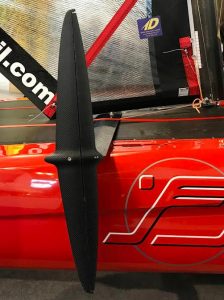
early take off in lightest breeze
F oiling maneuvers are heavily supported, superior flight attitude through active foil control, dynamic control of f light high , pitch and role, non-linear control and feedback control system for best flight stability, even in waves, the foils do not need to be manually manipulated, optimized performance: advanced sailors can adjust rake and gearing, more about flysafe®>>>, active flight assistance, the foil can be trimmed actively while sailing, the key to maximum performance , mdt for performance-orientated pro sailor, mdt extends the flysafe® foil control, to sail large xxl rigs, more about main foil differential ->>>, performance downwind: staying on the foils, full foiling, in 5-6kts tws, reaching max. boat speeds of up to 2.5*tws, performance upwind: full foiling from 8kts. tws, taking off from 7kts tws, video youtube channel, ifly15 foiling catamaran.

The most innovative development in foiling technology
About ifly15, stable flight is key for both: first for highest performance and foiling in a wide wind range, including rough and wavy conditions, but also easy access into foiling…...
iFLY stands for uniqueness in design and function. Its superior Flysafe ® active foil control system autonomously supports the stable horizontal flight position in the longitudinal and lateral direction. The 4 T-Foils do not have to be operated by the sailor during sailing.
Average skilled dinghy or catamaran sailors with some trapeze experience can safely foil with the iFLY15 after only a few hours. Quick access – the immediate sensation of success – steep learning curve. In the hand of an experienced sailor, iFLY15 offers a whole new sailing experience with previously not experienced speeds and agile maneuverability.
The flight control system, combined with numerous fine-tuned innovations , ensures safe foiling even in strong winds and rough seas.. Stable flight attitude allows pushing hard, so in good conditions, iFLY reaches high boat speed beyond 30 knots in a controllable way.
IFLY15 offers freedom to fly alone or in pairs. Due to the exclusive use of high-tech materials , iFLY15 is extremely rigid and weighs less than 90 kilos ready to sail. With its low weight and its state-of-the-art hydrofoils, it is airborne in winds as low as 2Bft. / 6 Knots.
iFLY15 has a length of only 15 feet, is easy to transport, quick to get ready to sail, and can be easily slipped from the beach using a conventional beach trolley.
Its sophisticated design reflects the highest demands on quality and function.
iFLY15 – customer reviews
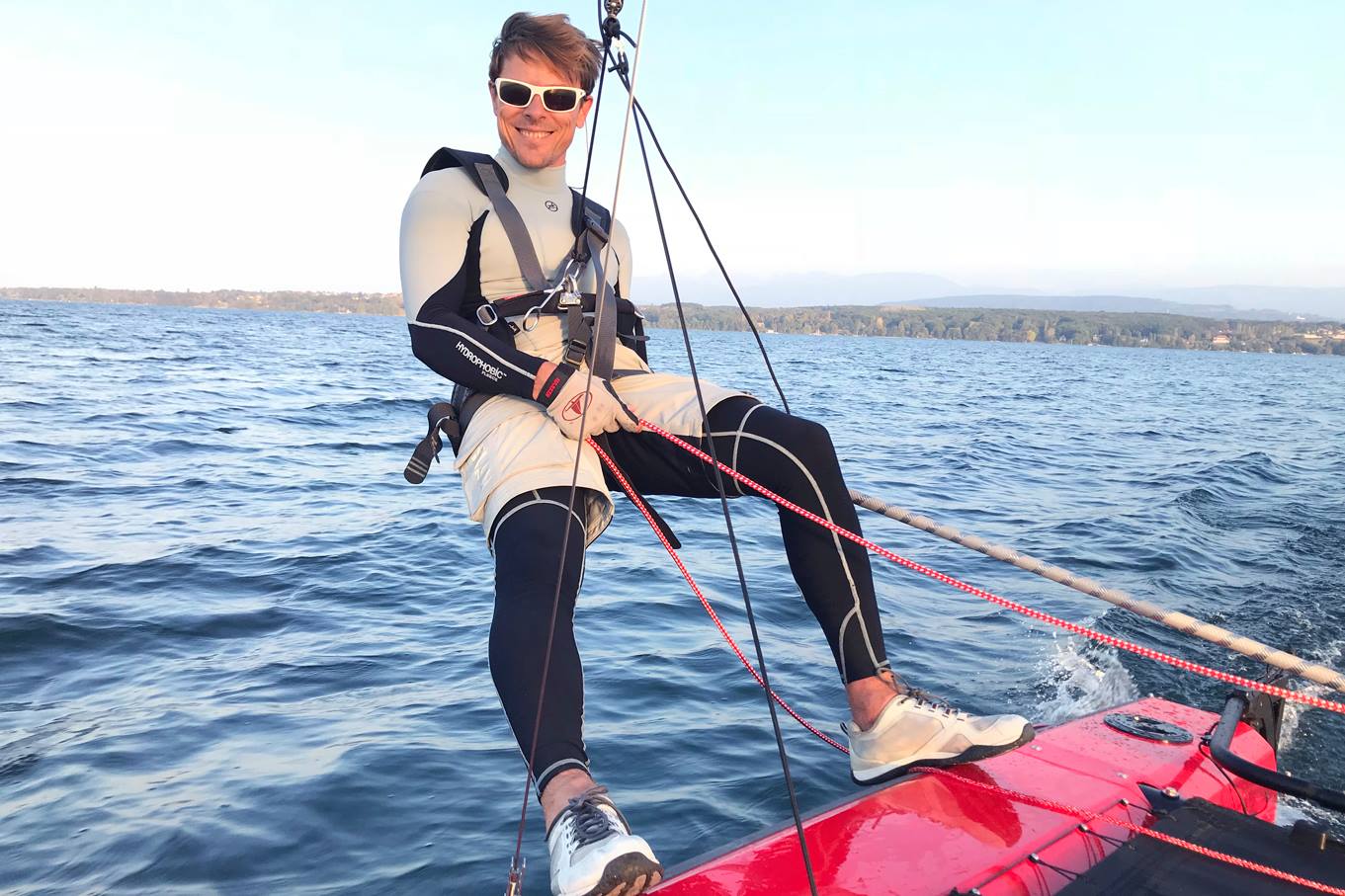
« LESS CRASHING IS MORE FUN »
MARCUS LYNCH, PROFESSIONAL SAILOR AND OLYMPIC COACH, GC32 OMAN, NACRA17
« I WAS INITIALLY AMAZED AT HOW EASY TO HANDLE THE IFLY IS AND AT HOW IDLE THE BOAT IS EVEN IN STRONG WINDS. »
ANTOINE, IFLY OWNER FROM GENEVA
VERY STABLE, EXTRAORDINARY STABLE. IT IS EXTREMELY INTERESTING, BECAUSE YOU IMMEDIATELY SEE THE ACCESSIBILITY OF THE BOAT.
FRANÇOIS GABART
« GREAT BOAT, LIKE A MOTH ON STEROIDS ! »
VICTOR DIAZ DE LEON, MIAMI, PROFESSIONAL SAILOR. US TEAM SAILGP, INTERNATIONAL MOTH, MATCHRACING MELGES 32, J70
WHAT A GREAT BOAT THIS IS, AND I ABSOLUTELY LOVE IT”
PHILIP WALKER
« THE DYNAMIC FLIGHT CONTROL SYSTEM ALLOWS LONG AND STABLE FLIGHTS »
GERHARD FLORIN, IFLY OWNER FROM GENEVA, SWITZERLAND
TO FELLOW SAILORS WHO LOVE THE THRILL OF SAILING WITH SPEED WHILE MAINTAINING CONTROL”
ROY BALLENTINE
« WELL BALANCED AND RAKE DIFFERENTIAL ALLOWING FOR GREAT PERFORMANCE UPWIND! »
CARLOS ROBLES,PROFESSIONAL SAILOR 49ER, PALMA DE MALLORCA
« A SENSATIONAL FOILING EXPERIENCE. THE SPEED IS IMPRESSIVE »
INGMAR WARNICKE: COMMODORE OF YCSO, YACHT CLUB SCHARBEUTZ, BALTIC SEA
⭐ ⭐ ⭐ ⭐ ⭐

IFLY RAZZOR PRO – THE NEW IFLY FOR EXPERIENCED SAILORS
THE SINCE 7 YEARS PROVEN IFLY15 WITH FLYSAFE® DYNMAMIC FOIL CONTROL has now a pur Racing fellow: THE iFLY RAZZOR Pro. THE iFLY racing VERSION ENABLES EVEN HIGHER PERFORMANCE, to sail in extremely tough conditions and allows sailing with XXL rigs. THE MAIN DIFFERENCE BETWEEN THE IFLY15 ONE DESIGN AND THE IFLY RAZZOR PRO IS A BIGGER RACING RIG, SPECIAL FOILS AND THE MAIN FOIL DIFFERENTIAL (MDT), WHICH IS MANUALLY TRIMMED BY THE SAILOR. THE MDT IS WORKING HAND IN HAND WITH THE FLYSAFE® DYNAMIC FOIL CONTROL SYSTEM.
flying – sailing – Blog
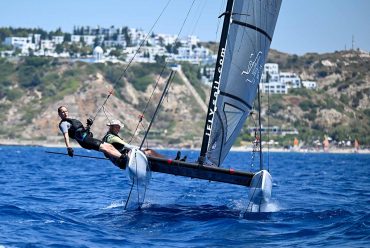
“We’re taking off! Foiling is THE Watersports Trend! – „Boot International 2024“ in Düsseldorf / Germany once again showcases: Foiling is THE trend in watersports.
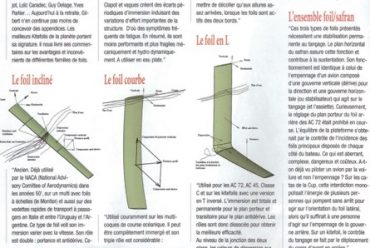
Performance Sailing – Sail GP News: Racing on the Edge – T-Foil proves to be the winning design

Regatta and foiling News: Long distance Race – Duc d’Albe 2023 – Club Multicoques Hyères – sailing Race @iFLY Razzor Pro
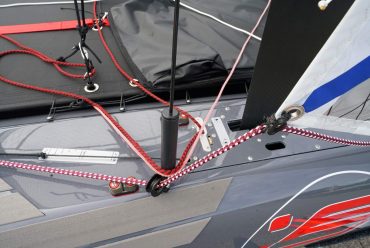
iFLY Main Foil Differential Technology – MDT Foil Control – high Performance sailing
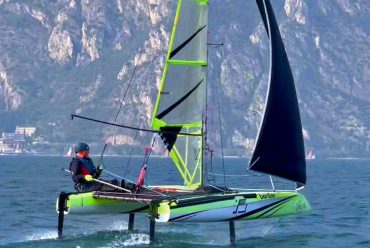
IFLY FOILING Adventure
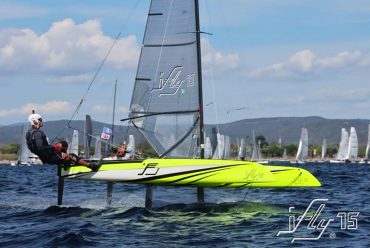
FOILING – REGATTA – EVENTS
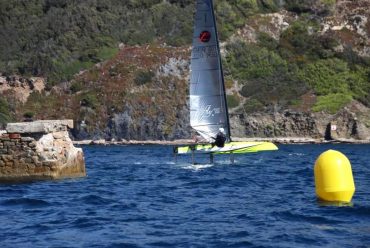
Long distance Race – Duc d’Albe 2021 – Club Multicoques Hyères – sailing Race @iFLY Razzor Pro
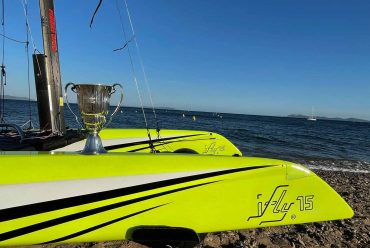
INTERNATIONAL IFLY foiling FLEET RACE 2021

iFLY15 successfully crossing the English channel / world record Attempt Cowes to Dinard / Saint Malo
Catamaran europe central, the iflysail team, is looking forward to your message.

Support our hydrofoil educational content for free when you purchase through links on our site. Learn more
[2023] Hydrofoil Yacht: The Ultimate Guide to Sailing on Foils
- November 1, 2023
- Hydrofoil Basics
Quick Answer: A hydrofoil yacht is a sailboat equipped with wing-like foils that lift the hull out of the water as it gains speed. This reduces drag, increases speed, and provides a smoother ride. Hydrofoil yachts can be retrofitted on both monohull and multihull sailboats, with different types of foils used for stability and control.
Welcome to Hydrofoiling™, where we bring you all the latest and greatest information about hydrofoil boarding. In this comprehensive guide, we’ll dive into the world of hydrofoil yachts, exploring their history, configurations, classes, and more. Whether you’re a seasoned sailor or a curious beginner, this article will provide you with expert advice and insights into the exciting world of hydrofoil yachts.
Table of Contents
Quick answer, quick tips and facts, background: the evolution of hydrofoil yachts, types of hydrofoil yachts, hydrofoil classes: from moths to ac75, hydrofoil yacht brands and models, advantages and disadvantages of hydrofoil yachts.
- Recommended Links
- Reference Links
A hydrofoil yacht is a sailboat equipped with wing-like foils that lift the hull out of the water as it gains speed. This lifting action reduces the wetted area of the hull, minimizing drag and allowing the yacht to achieve higher speeds. Hydrofoil yachts can be retrofitted on both monohull and multihull sailboats, with different types of foils used for stability and control.
Shopping Links: Check out hydrofoil yacht products on Amazon | Shop hydrofoil yacht on Walmart | Etsy hydrofoil yacht products
- Hydrofoil yachts use foils to lift the hull out of the water, reducing drag and increasing speed.
- Different types of foils, such as T foils, C foils, S foils, and L foils, are used for stability and control.
- Hydrofoil yachts can be retrofitted on both monohull and multihull sailboats.
- The International Moth class is one of the most widespread uses of hydrofoils in sailboats.
- Hydrofoil yachts can achieve impressive speeds, with some reaching over 50 knots.
Hydrofoil technology has been around for over a century, with the first patent for a hydrofoil boat filed in 1898 by Italian engineer Enrico Forlanini. Since then, hydrofoil yachts have undergone significant advancements, transforming the sailing experience and pushing the boundaries of speed and performance.
The concept behind hydrofoil yachts is simple yet ingenious. By using wing-like foils mounted under the hull, these yachts can lift themselves out of the water as they gain speed. This lifting action reduces the wetted area of the hull, minimizing drag and allowing the yacht to glide effortlessly through the water.
Hydrofoil yachts come in various configurations, each designed to optimize performance and stability. Let’s explore some of the most common types of hydrofoil yachts:
Monohull Hydrofoil Yachts : Monohull hydrofoil yachts feature a single hull and employ a “ladder” arrangement of hydrofoils. These hydrofoils typically have a dihedral angle of around 50 degrees and are complemented by a stabilizing rudder foil. This configuration provides stability and control, allowing the yacht to sail smoothly on foils.
Multihull Hydrofoil Yachts : Multihull hydrofoil yachts, such as catamarans and trimarans, offer increased stability and performance. These yachts use wider planforms, allowing for greater lift and control. Some multihulls utilize three foils, with two main forward foils providing lift and a horizontal foil on the rudder for additional control.
Hydrofoil Catamarans : Hydrofoil catamarans, also known as foilcats, combine the stability of a catamaran with the speed and efficiency of hydrofoils. These yachts can achieve impressive speeds while maintaining excellent stability, making them popular choices for racing and recreational sailing.
Hydrofoil technology has found its way into various sailing classes, revolutionizing the way we sail. Let’s take a closer look at some of the notable hydrofoil classes:
International Moth : The International Moth class is one of the most widespread uses of hydrofoils in sailboats. These single-handed dinghies feature foiling capabilities, allowing sailors to achieve incredible speeds and maneuverability. The class has seen rapid growth since 2001, with carbon fiber foils and advanced design techniques pushing the boundaries of performance.
Waszp : The Waszp class is similar to the International Moth class but utilizes aluminum foils instead of carbon fiber. This makes the Waszp more accessible to a wider range of sailors while still providing the exhilaration of foiling.
AC75 : The AC75 is a foiling monohull sailboat class used in the 2021 America’s Cup. These impressive yachts can reach speeds of up to 50 knots, showcasing the incredible potential of hydrofoil technology in the world of competitive sailing.
IQFoil : The IQFoil windsurfer class was selected by World Sailing for the 2024 Summer Olympics. These windsurfers feature hydrofoils, allowing athletes to glide above the water and achieve impressive speeds.
IMOCA 60 : Originally designed as non-foiling offshore racers, the IMOCA 60 class has embraced hydrofoil technology. These yachts now feature S-shaped daggerboard foils, providing partial foiling capabilities and enhancing performance in various conditions.
F50 : The F50 sailboat class is used in the SailGP series and is the first sailboat class to break the 50-knot barrier during a race, with a top speed of 52.2 knots. These high-performance catamarans showcase the incredible speed and agility that hydrofoil technology can offer.
Several brands have embraced hydrofoil technology, offering a range of hydrofoil yachts to cater to different sailing preferences. Here are some notable hydrofoil yacht brands and models:
Gunboat : Gunboat is a renowned brand in the world of luxury hydrofoil yachts. Their models, such as the Gunboat 68 and Gunboat 72, combine performance, comfort, and elegance, providing an exceptional sailing experience.
GC32 : The GC32 is a hydrofoil catamaran designed for high-performance racing. This foiling catamaran offers thrilling speeds and precise control, making it a favorite among competitive sailors.
AC72 and AC45f/AC50 : These hydrofoil catamarans were used in the America’s Cup, showcasing the cutting-edge technology and innovation in the world of hydrofoil yachts. These yachts pushed the boundaries of speed and performance, captivating sailing enthusiasts worldwide.
Nacra 17 and Nacra F20 : Nacra is a well-known brand in the world of multihull sailing, and their Nacra 17 and Nacra F20 models feature hydrofoil capabilities. These yachts offer a perfect balance of speed, stability, and maneuverability, making them popular choices for recreational and competitive sailing.
Hydrofoil yachts offer a range of advantages that make them appealing to sailors seeking speed, performance, and an exhilarating sailing experience. However, they also come with some drawbacks. Let’s explore the pros and cons of hydrofoil yachts:
Advantages:
Increased Speed : Hydrofoil yachts can achieve impressive speeds, thanks to reduced drag and increased lift. This allows sailors to cover more distance in less time, making hydrofoil yachts ideal for racing or simply enjoying the thrill of speed on the water.
Smooth Ride : By lifting the hull out of the water, hydrofoil yachts provide a smoother and more comfortable sailing experience. The reduced contact with the water minimizes the impact of waves and chop, resulting in a smoother ride even in rough conditions.
Improved Efficiency : Hydrofoil yachts are more efficient than traditional sailboats, thanks to reduced drag and improved lift. This increased efficiency translates to better performance and reduced energy consumption, making hydrofoil yachts an environmentally friendly choice.
Disadvantages:
Complex Design : Hydrofoil yachts require a more complex design compared to traditional sailboats. The addition of foils and the associated control systems can increase the complexity of the yacht, requiring more maintenance and potentially higher costs.
Learning Curve : Sailing a hydrofoil yacht requires a certain level of skill and experience. The handling and control of a hydrofoil yacht can be more challenging compared to traditional sailboats, requiring sailors to adapt to the unique characteristics of foiling.
Higher Costs : Hydrofoil yachts, especially high-performance models, can come with a higher price tag compared to traditional sailboats. The advanced technology, materials, and design required for hydrofoil yachts contribute to their higher cost.
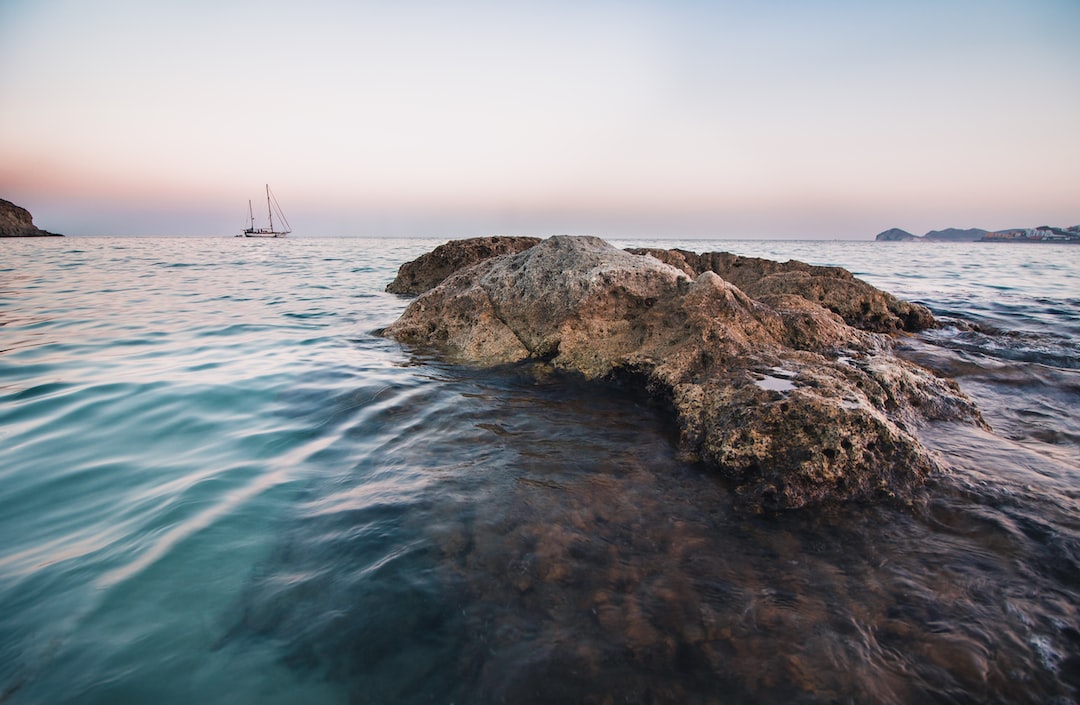
How fast is the hydrofoil racing yacht?
Hydrofoil racing yachts can achieve impressive speeds, with some models reaching over 50 knots (57.5 mph or 92.6 km/h). The F50 sailboat class, used in the SailGP series, holds the record for the fastest sailboat class, with a top speed of 52.2 knots (60 mph or 97 km/h).
What does a hydrofoil do to a boat?
A hydrofoil lifts the hull of a boat out of the water as it gains speed. This reduces the wetted area of the hull, minimizing drag and allowing the boat to achieve higher speeds. The lifting action of the hydrofoil also provides a smoother ride by reducing the impact of waves and chop.
Read more about “… Hydrofoil Catamaran: The Ultimate Guide to Foiling on Water”
How fast do hydrofoil boats go?
Hydrofoil boats can reach impressive speeds, depending on their design and purpose. Racing hydrofoil yachts can achieve speeds over 50 knots (57.5 mph or 92.6 km/h), while recreational hydrofoil boats can reach speeds of 20-30 knots (23-34.5 mph or 37-55.5 km/h) or more.
Why don’t boats use hydrofoils?
While hydrofoils offer significant advantages in terms of speed and efficiency, they also come with certain limitations. The complex design and higher costs associated with hydrofoils can be prohibitive for some boat owners. Additionally, the handling and control of hydrofoil boats require a certain level of skill and experience, making them less accessible to novice sailors.
Read more about “… Why do boats not use hydrofoils?”
Hydrofoil yachts have revolutionized the sailing experience, offering increased speed, improved efficiency, and a smoother ride. Whether you’re a competitive sailor looking for the thrill of high-speed racing or a recreational sailor seeking a more exhilarating sailing experience, hydrofoil yachts provide an exciting and innovative option.
Recommended Links:
- Hydrofoil History
- Advanced Hydrofoiling Techniques
- Hydrofoil Equipment Reviews
- How Do Hydrofoils Work on Boats? 2023
Reference Links:
- Sailing Hydrofoil – Wikipedia
- Gunboat Official Website
- Nacra Official Website
- SailGP Official Website
- America’s Cup Official Website
Now that you have a comprehensive understanding of hydrofoil yachts, it’s time to set sail and experience the thrill of foiling firsthand. Whether you’re racing on the high seas or cruising along the coast, a hydrofoil yacht will take your sailing adventures to new heights. Happy foiling!
Disclaimer: The information provided in this article is based on research and personal experience. Hydrofoiling™ is not affiliated with any specific brand or product mentioned in this article. Always consult with experts and follow safety guidelines when engaging in hydrofoil activities.
Review Team
The Popular Brands Review Team is a collective of seasoned professionals boasting an extensive and varied portfolio in the field of product evaluation. Composed of experts with specialties across a myriad of industries, the team’s collective experience spans across numerous decades, allowing them a unique depth and breadth of understanding when it comes to reviewing different brands and products.
Leaders in their respective fields, the team's expertise ranges from technology and electronics to fashion, luxury goods, outdoor and sports equipment, and even food and beverages. Their years of dedication and acute understanding of their sectors have given them an uncanny ability to discern the most subtle nuances of product design, functionality, and overall quality.
Related Posts
What are hydrofoil ferry vessels well known for [2024] 🚀.
- April 12, 2024
What is a Hydrofoil Ferry? [2024] 🚢
Best hydrofoiling for beginners: a comprehensive guide [2024] ✅.
- April 9, 2024
Leave a Reply Cancel Reply
Your email address will not be published. Required fields are marked *
Add Comment *
Save my name, email, and website in this browser for the next time I comment.
Post Comment
Trending now
F1x A-class foiling catamaran
World champion, lighter = better, craftsmanship, meet the foiling f1x a-class catamaran.
This is the ultimate singlehanded foiling catamaran of the moment: ultramodern, incredibly fast, very agile, extremely strong and feather-light, in an aerodynamic and ergonomic design. The perfect total package, packed in 1 foiling catamaran. This is the world’s coolest boat for singlehanded races and the winner of several A-cat world championships and many other sailing races.
The 2020-F1x A-cat is exactly the same foiling catamaran that made Mischa Heemskerk Vice-World Champion at the Herveybay Worlds 2018 in Australia and World Champion at Weymouth 2019. All our foiling F1x A-class catamarans come straight, ready to race and ‘Mischa-tuned’ from our factory.
Unique design enables top performances
The F1x A-class foiling catamaran is the ultimate reflection of our current design language. The aerodynamic design accentuates the performance qualities of this super fast foiling racing boat. The sophisticated deck plan provides clear control and minimal air resistance.
Foils The rudders and daggerboard foils used on the F1x A-class foiling catamarans are produced with the highest quality carbon pre-preg fibers. The foils are cured in our own Autoclave . Our winning foil design was created in close cooperation with Glenn Ashby and the designers of AC Team New Zealand .
Construction The F1x A-cat is manufactured entirely according to the carbon pre-preg/ Nomex production method, and cured in our Autoclave. This technology is the same as used in the aerospace industry and within other foiling boats like for example, the America’s Cup.
Design The design of the F1x foiling A-class catamaran was completely conceived by the DNA design team and made at DNA’s own yard. In the DNA design team Pieterjan Dwarshuis, Mischa Heemskerk and the renowned Dutch industrial design engineer Rudo Enserink worked closely together to create the perfect foiling A-class catamaran.
We build your new foiling boat!
Technical details.
The F1x A-class foiling catamaran has a number of unique features that improve performance. For example:
- Semi ridged trampoline. Gives extra torsional stiffness to the boat and increases its aerodynamic characteristics.
- Patented main-sheet-wheel-system. For more direct and faster trim of the main sail.
- Aerodynamically placed traveller car.
- Flexible daggerboard casings. For minimal water absorption in floating mode.
- Aerodynamically shaped ‘beams’.
- Adjustable T-rudders. Foiling with rudder differential is possible.
Specifications
LOA: 5.49 m BOA: 2.30 m Max. draught: 1.20 m Sail area: 13.94 m Total weight: ca. 53 kg Top speed: 31 kn Extra: All measurements according to IACA Class regulations.
Buy a champion's boat!
Are you excited to buy a F1x A-class foiling catamaran from DNA Performance Sailing? Please fill in our contact form:
Yes, I want a F1x A-cat!
Schrijf je in voor onze nieuwsbrief en blijf op de hoogte van de nieuwste ontwikkelingen.
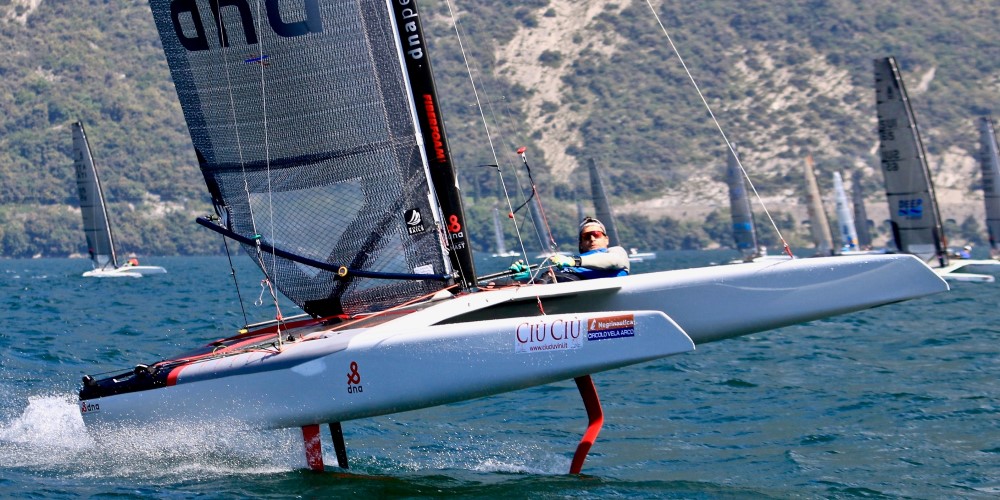
Contactformulier
- Company Name
- Full name * First Last
- Emailaddress *
- Phonenumber *
- Mijn vraag betreft * My question: TF10 F1x G4 F4 Custom Parts Hydrofoils Other
- Phone This field is for validation purposes and should be left unchanged.
Registrieren Sie sich für unseren Newsletter
lassen Sie sich über die neuesten Entwicklungen informieren!
- E-Mail-Adresse *
- Name This field is for validation purposes and should be left unchanged.
Schrijf je in voor onze nieuwsbrief
blijf op de hoogte van de nieuwste ontwikkelingen!
- First name *
- Last name *
- Email This field is for validation purposes and should be left unchanged.
Wij gebruiken cookies om u de beste online ervaring te bieden. Door akkoord te gaan, accepteert u het gebruik van cookies in overeenstemming met ons cookiebeleid.
Wanneer u een website bezoekt, kan deze informatie in uw browser opslaan of ophalen, meestal in de vorm van cookies. Beheer hier uw persoonlijke cookiediensten.
- wordpress_test_cookie
- wordpress_logged_in_
- wordpress_sec
- Yachting World
- Digital Edition

Sailing the new foiling Birdyfish dinghy
- March 24, 2022
The BirdyFish is a dinghy that aims to make foiling accessible to sailors of all levels. François Tregouet took it for a test sail to see if it really does bring foiling within reach

Based on an engineering school graduation project, three young Frenchmen have created the BirdyFish, a dinghy that aims to make foiling accessible to everyone.
BirdyFish is the story of a sailing start-up, something western France does well. Near Nantes, Jean-Baptiste Morin, Pierre Rhimbault and Alban Satgé were not yet 25 years old when they started out to create a new class of boat. Foiling designs fascinated them, from the Mini Transat small yachts to IMOCA 60s , but they wanted to make flying on the water easier.
Ambitious but realistic, the trio focused on the business and management of the project, and turned to specialists for key areas. Naval architect Etienne Bertrand, well known for his work on the Mini, was commissioned to design the BirdyFish, whose beamy bow is reminiscent of the 6.5m Mini ocean crossing scows.
With their personal savings and a €10,000 grant from a foundation for young entrepreneurs, they built a prototype. Three years later they’re on the verge of finalising a €250,000 fundraising operation and moving to 600m² premises to scale up to mass production.
While the hulls are subcontracted a few kilometres south, the foils are built in Nantes, in-house, a key factor in controlling the quality of these essential parts.

Under gennaker the flying experience starts with less than 10 knots of wind. Crew position determines trim. Photo: BirdyFish
Foil design was entrusted to a master of the art, Jean Baptiste Behm. With their J-shape, the foils create maximum lift when fully deployed but remain quite simple to retract. The carbon foils weigh 10kg each and are symmetrical, so can be used on either side of the boat. This simplifies production and after sales service.
Also with simplicity in mind, the position of the foils is fixed, without any adjustment. Rudder rake can be adjusted but to enable good control of the helm the rudder profile is not extreme.
A longer rudder chord means a little more drag but also more tolerance, and less risk of losing control. Sailing at low speeds with a smaller rudder surface area would give no feel to the tiller, making it much more difficult for beginners. The development of the Birdyfish, and refining that balance, took more than two years.
The hull is made of a glass-polyester sandwich, weighs 93kg and has four watertight zones making it unsinkable. The mast is aluminium and, once the foot is unpinned, can be dropped backwards with a crewmember controlling the descent with a halyard in hand.

The maximum speed recorded by a BirdyFish is 22 knots (like a Class 40 but 40 times cheaper!). Photo: MULTImedia/François Tregouet
The BirdyFish is limited to three sails to keep it simple. There’s no trapeze either, the righting moment being entrusted to the foils. This is also a safety choice because, at high speed, any fall could be dangerous. Two crewmembers sit on the gunwale, or move slightly outboard upwind with their feet in the straps.
A major evolution in the development of the BirdyFish means there is also no longer a daggerboard. The first boats sold played their part as pioneers, but it turns out that the foils, although symmetrical, generate more anti-leeway effect than expected. Removal of the daggerboard and its box made the Birdyfish’s cockpit even simpler.

Each foil weighs just 10kg (22lb) and they are symmetrical on port and starboard. Photo: MULTImedia – François Tregouet
Officially, the BirdyFish will fly in upwards of 12 knots of wind. But with a trained crew, the boat can take off from 8 knots. Finding the right angle, producing just the right amount of power at the right time to get the hull out of the water will show the difference between a novice crew and one that already has a few hours of flying experience.
Rusty from decades of cruising on non-foiling boats (and having long forgotten my 420 and Mini years), for me trying the BirdyFish felt like a good test of its genuine accessibility to all. I returned to the shore reassured about my abilities – but more importantly blown away by the extraordinary sensations of flight.
Off the beach at La Rochelle the BirdyFish flew very fast at about 15 knots in a wind oscillating between 10-15 knots. High speed means constant vigilance is essential: the transparent Mylar window in the jib helps with visibility.

There are no more lines at the mast foot than on a classic dinghy: simple. Fittings are attached so as not to compromise watertight zones. Photo: MULTImedia – François Tregouet
As there are no flaps to adjust the boat’s trim it’s the crew’s position that needs to be tweaked. Sitting on the windward side of the boat, well wedged against the shroud, I was quietly enjoying the stability of the boat – its tolerant foils and T-shaped rudder do a remarkable job – when Jean-Baptiste Morin handed over the helm.
I was instructed to use as little helm angle as possible, instead using the mainsheet as an accelerator first, then as a damper. Very quickly, the miracle happened, and we took off! Soon we were flying, perfectly dry just above the chop.
I quickly learned that to remain foiling requires being very sensitive to movement. Rudder correction angles must be as small as possible. There’s no question of moving the whole tiller, instead Jean-Baptiste advised I keep my tiller hand close to my body and only make small movements using just the span of my fingers.

When transporting or storing, the self-regulating J-foils fit inside the cockpit. Photo: MULTImedia – François Tregouet
Course deviations must also be very limited. I estimate that the maximum allowed is more or less 2° around the true wind direction without trimming the sails. The penalty for overdoing it is immediate: the BirdyFish touches down, either softly or more brutally.
Tacking and gybing are not difficult, but it takes a little more experience to complete them in ‘flight’ mode. To demonstrate, Jean-Baptiste retook control of the boat for a series of foiling gybes. Crouching at the front of the cockpit, my role was limited to managing the Solent sheet and above all to hold on, as the rate of turn is brutal, a reminder of the extraordinary performance achieved.

The foil housing is slightly smaller than its well. Foil rake setting is fixed by four bolts: no brain work required. Photo: MULTImedia – François Tregouet
Only twice have I reached 18 knots at the helm of a sailing boat on my first try, and those were on a Gunboat 68 and an 80ft Ultim trimaran – very different budgets to the €18,840 standard BirdyFish.
Three essential options do raise the bill to €21,200 – it’s difficult to do without the jib furler for manoeuvres, a Code 0 with furler offers light airs performance, and a launching trailer is essential for the 135kg (297lb) whole package – but if you want to go foiling for a reasonable budget and with little experience, the BirdyFish rocket hits the target.
BirdyFish specifications
LOA: 4.70m / 15ft 5in Beam: 1.90m / 6ft 3in Draught: 0.90m / 2ft 11in Displacement: 135kg / 297lb Upwind sail area: 13.5m² / 140ft² Downwind sail area: 24.5m² / 258ft²
If you enjoyed this….
Yachting World is the world’s leading magazine for bluewater cruisers and offshore sailors. Every month we have inspirational adventures and practical features to help you realise your sailing dreams. Build your knowledge with a subscription delivered to your door. See our latest offers and save at least 30% off the cover price.
- Nautic Shows
- America’s Cup
- Classic Yachts
- Motor Yachts
- Sailing Yachts
- Superyachts
- Yachts News
- Destinations
- Yacht Clubs
- Boat Racing
- Meta Yachts

In fact, on April 18, Genoa will host the 7th edition of the “Foiling Awards,” which honors the best projects in the foiling world over the past 12 months. There are also the innovative, unique and extraordinary sailboats.
The “flying” sail, that of foils, the special appendages that allow boats to rise and sail above the water reaching incredible speeds is the fashion of the moment. And prizes are awarded in Genoa for the best projects. In fact, on April 18, the Ligurian city will host the 7th edition of the “Foiling Awards,” which are the awards for the best athletes, projects and products in the foiling world over the past 12 months.
There is also no shortage of best flying sailboats among the nominations. For the One Off category there are: For People Imoca Cdk, Baltic Raven 111 and Paprec Arkea Imoca. For the Production Boats category we have: Gerys 4.7 and Switch. And finally in the Project category are: Skaw and Ferrari 100ft Ocean Foiler. Here then in detail are all the models nominated for the award.

For People Imoca Cdk: Vendée Globe goal.
Among the flying boats, the new Imoca 60 “For People” aboard which Thomas Ruyant will participate in the upcoming Vendée Globe immediately attracted interest both because the French skipper is a favorite for the solo round-the-world race and because the project brings with it some interesting ideas. It is the result of a collaboration between naval architects Antoine Koch and Finot-Conq, engineering design company GSea Design, and Breton shipyard CDK Technologies.
And it launches water lines unprecedented compared to the rest of Imoca’s new designs: the bow and stern sections are very narrow and flared toward the edge with skinny volumes. A choice in favor of speed even in light winds, thus in the transitional phases between weather systems typical of the Vendée Globe and especially of foil sailing. Also by having a hull shape that is not flat, but rather shows an almost “U” shape, impacts on waves should be softer.

Baltic 111 Raven, the megayacht with America’s Cup foils
Baltic 111 Raven is a 34-meter-long, foil-equipped sailing superyacht. It is a high-performance yet comfortable boat designed for short high-speed cruises. The project was designed by Botin Partners and PURE Design, two names at the forefront of yacht building including America’s Cup yachts. Among its main features are two huge T-shaped laminar surfaces, mounted on two hydraulically operated side arms, which are able to support part of the boat’s displacement (55 tons). At the stern, Raven is equipped with “Interceptor flaps” capable of adjusting bow and stern trim at speed, as on powerboats. In addition, there is a movable water ballast, with two built-in tanks, which helps to increase the righting moment during navigation.
The hull and deck construction is pre-preg carbon fiber IM with a Kevlar honeycomb sandwich. Raven’s interior, designed by Jarkko Jämsén, is made of exposed carbon with a Nomex core to ensure low weight and ultra-modern styling. The glazed sides of the large cockpit stand out, forming a kind of inverted observation “dome” with Perspex windows that allows occupants to see the interior. The propulsion system of the Baltic 111 Raven is a diesel-electric hybrid to reduce emissions and achieve efficient weight distribution.

Paprec Arkea Imoca: it drives like an offshore
The other Imoca 60 in contention for the Foiling Awards is “Paprec Arkéa” by sailor Yoann Richomme. Architects Antoine Koch and Finot-Conq signed this project while the construction site is Multiplast. Underlying the design are two important features. First, its very high pointed bow is free of water, designed to cleave the sea, unlike more recent designs that are more like scow. The deck, on the other hand, is very round to quickly evacuate water at the sides. Everything is clean and essential: the central slide brings all maneuvers forward, while two large footboards serve as solid supports for going to the front of the boat if necessary.
The other feature of the boat is the unique living quarters under the canopy, with an important forward view for navigation. Behind the side windows is the guard station with a view of the computers, foil settings, and outside. The idea is to have the skipper move very little to make any adjustments to the boat. Again, the target is the most prestigious international regattas, from Transat Jacques Vabre to Vendée Globe.

Gerys 4.7, the drift-school with foils
A boat with foils can also be suitable for sailing schools. This is the belief of French brothers Raphaël and Erwan Censier, who have launched the Gerys 4.7 in their Gerys shipyard. Already on an aesthetic level, the 4.70-meter-long project boasts some distinctive features: the shapes are decidedly soft, almost not looking like those of a sailboat, but definitely resembling those of a dinghy. The soft volumes in the bow, wide hull, and spacious cockpit that can accommodate up to 3 crew also stand out.
And then of course there are the foils that are L-shaped but with a soft angle. Appendages in cool breeze conditions always remain submerged to ensure boat flight and do not need to be adjusted. If the wind is less than 8 knots, the boat can sail safely without a foil, since it is equipped with a classic daggerboard and its hull is also designed to go in displacement mode, and a Code Zero can also be rigged on the bowsprit if necessary.

Switch: the anti-Moth has arrived
It is called Switch and is a new foiler one design thought up in Italy. 3.9 m long and 2.25 m wide (with the “wings”), it is ultralight due to its full-carbon construction and is capable of flying at 30 knots of speed on its inverted-T appendages and taking off as early as 5-6 knots of wind. Already some are calling it the anti-Moth. It was made on Lake Garda by brothers Gian Maria and Stefano Ferrighi, two young designers (born in 1996) in love with foiling who worked in Australia for major design firms before founding the composites specialist company, Garda Carbon Lab.
The goal of the Switch project was to get a boat that is easy to use on the water and in “flight,” convenient to handle (it fits in a box you can put on top of the car, the mast unfolds in three pieces, and the decks can be disassembled in minutes), inexpensive, and very narrow monotype. Flying on the Switch is simple: the “wand,” or bow stick, controls the automatic adjustment of the center inverted-T foil in flight. Three sail plans are provided for ease of use from the very young to the very experienced. From 6.5 (Youth), 7.5 (Women) and 8.4 sq m (Men), with One Design Quantum Membrane Sail sails.

Skaw 38, the 11-meter cruiser with foil and XXL interior
A round bow boat with foil and pivoting keel designed for cruising and designed as an oceanic open. This is the vocation of the Skaw 38 designed by French design studio Berco Design of Nantes. An absolutely innovative boat: just think that it has a beam of almost 5 meters (a normal 38-foot cruising boat does not reach 4 meters). The cockpit, where the double wheelhouse is located, is asymmetrical, wide and protected by a hard-top, a solution borrowed from the world of catamarans, which opens at its rear. The transom opens up, transforming into a bathing platform, while a very large sunbathing area opens up forward of the boom.
The Skaw 38’s interior is designed to be like a single open space, with the boat’s full-beam deckhouse equipped with long windows that run from bow to stern and brightly illuminate the space. In the bow, one can opt for one or two cabins: the modularity of the interior makes possible configurations easier. As for self-adjusting C-foils, they are not intended to lift the boat completely out of the water, but rather to make it more stable, reduce the wetted area (drag) and provide a huge increase in righting moment. These positive spirals allow cruising speeds between 15-20 knots in full control and comfort.

Ferrari Foiler, Soldini’s new full foiling
The result of an investment by Ferrari of 20 million euros, the Ferrari Foiler is a 30.48-meter-long monohull that is full foiling, that is, capable of sailing completely lifted out of the water. The designer of Giovanni Soldini’s new super flying boat is Frenchman Guillame Verdier, who had already overseen the creation of the foils on Maserati’s Multi 70 trimaran and is currently part of the design team of AC75 Team New Zealand. But many Made in Italy companies and excellences are participating in the project, including Cariboni for all hydraulic and hydraulic handling (foil booms, etc.).
The goal of Giovanni’s boat, capable of sailing at 50 knots, is to break the record on the Jules Verne Trophy round-the-world voyage, which to date is that set by Francis Joyon’s trimaran IDEC Sport (40 days, 23 hours, 30 minutes and 30 seconds) at 26.90 knots average, with peaks between 38 and 44 knots. This will be a cutting-edge project in terms of technology and energy, and we will see systems on board that are not unique to the sailing world. Goal: minimization of consumption as well as energy autonomy, which is very difficult to achieve on large boats.
- flying boats
- Foiling Awards
RELATED ARTICLES
Us sailing announces 2023 yachtsman and yachtswoman of the year, the ocean race wins the sustainability award in the international sports awards 2023, neuschäfer and slingsby crowned at world sailing awards in malaga, world sailing awards 2023 to recognise this year’s highest achievers, sy nyumba wins the international superyacht society award 2023, sailing’s best to be celebrated at 2023 world sailing awards in málaga.
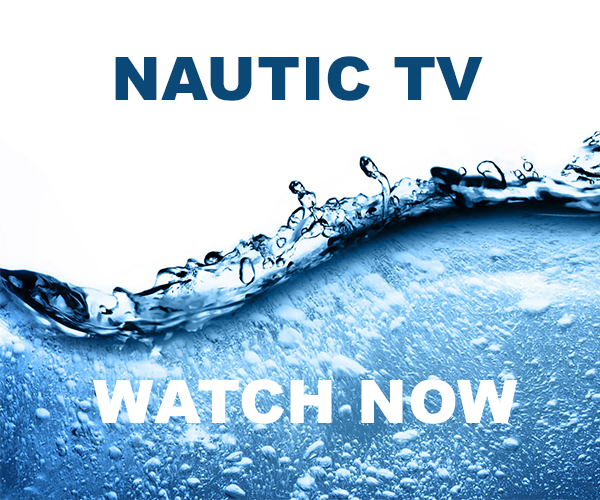
Subscribe to our newsletter
To be updated with all the latest news, offers and special announcements.
LATEST ARTICLES
Unleashing potential: emirates team new zealand’s two-boat training session, nyyc american magic’s intensive training session amidst barcelona’s spring blues, magic start to the rolex china sea race 2024, rising stars shine bright: youth talent takes center stage in hauraki gulf, editor picks, canadian beau lake introduces the tahoe ’14 and lugano ’14 electric runabouts, underwater adventure and exploration with deepflight’s super falcon 3s, driving performance on land and on water: 41′ amg carbon edition, popular posts, young designer of the year 2022: ioana valentina corcodel reveals 65m ophelia concept, mirabaud sailing video of the century: celebrating 2 decades of passion, superyacht the flying fox seized in the dominican republic, popular category.
- Regatta 811
- America's Cup 384
- Motor Yachts 263
- Boating 215
- Superyachts 183
- Sailing 178
- Yachts News 174
- Sailing Yachts 162

Although I had the daggerboard shaped with a CNC router, it is possible to shape a high aspect ratio, fully streamlined foil in the home shop. I’ll walk you through my second project, a kick-up rudder blade that I made at home to replace the original one I built for FIRE-DRAKE. I settled on a planform that is one-quarter of an ellipse with an elliptical leading edge and a straight trailing edge. (The shape would move the center of lateral resistance of the boat aft a few inches, and is intended to lighten the weather helm I’d experienced with the original rubber blade.) I drew the new blade with an aspect ratio of 2.5:1, with a length of 30″ (762 mm) and a maximum chord width of 12″ (305 mm), which would increase the lift and reduce the tip vortex drag.
To draw the planform shape of the quarter ellipse you can use an online graphing tool such as Desmos for a full ellipse. If you center the ellipse at zero, you can drag the two axes out until you get the aspect ratio you want. Since the graph has a grid in the background, you can then print out a screen capture of a quarter of the resulting ellipse and scale up the printed image to the actual dimensions required. If you are comfortable with computers, you can download and run Freeship (available for Windows only) which has a “keel and rudder wizard” that accurately generates several different planforms.
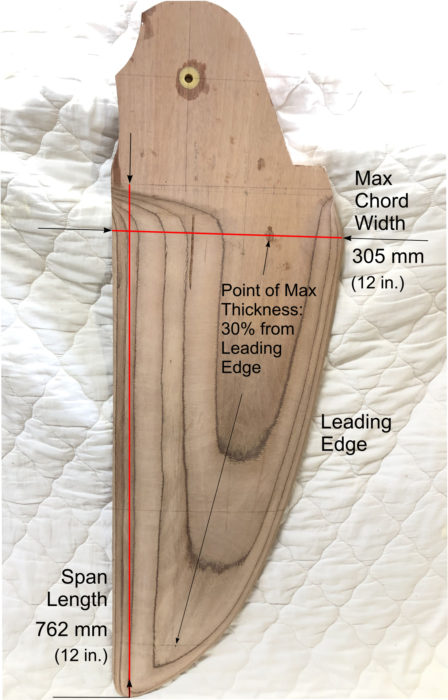
The new rudder blade for FIRE-DRAKE has a quarter-ellipse planform. The plywood’s glue lines show the contours that help with shaping the foil.
Obtaining the cross-section profile of a chord of a given width is best left to a computer. For any of the NACA foils, like the 0010 foil I mentioned above, Competition Composites Inc . (CCI) has a very simple and handy calculator . You need enter only the chord width and the maximum thickness and it will generate a table of X-Y coordinates that you can copy and print out. They’ll be your offsets for drawing a pattern for the foil cross-section. If you intend to sheathe your foil with ’glass and epoxy, for example, you can also enter the skin thickness and it will calculate the coordinates for the plywood core.
Now, here’s the tricky bit. If you have a rectangular foil planform, you only have one chord width and therefore one section profile for the entire length of the foil. However, if you have any other planform (e.g., half-ellipse, quarter-ellipse, trapezoidal, straight-chord-quarter-line, etc.), the thickness, which will be one-tenth of the chord width, changes along the length of the foil because the chord width changes.
I used the CCI calculator to generate profile coordinates for three different points along the length of the rudder blade: at the root, at about two-thirds of the way along and at about 90 percent of the way to the end. I chose those points because the chord width for my quarter ellipse planform doesn’t change much for the first half of its length, but it changes more quickly toward the tip. The idea is to shape the foil to these profiles at these points and then taper the foil evenly between them. You can lay out your foil plan directly on to the ply or you can use something thin, like doorskin, to make and fine-tune a template, which is what I did.
I made a blank for my rudder by gluing layers of marine ply with epoxy to the required 1″ thickness. I have found that the plywood, in spite of its cross-grain plies, has sufficient strength for the size of small-boat foils that I have built (though the cross-grain would weaken a long thin foil). Plywood does not warp and has the added advantage over solid wood in that the plies create a kind of contour map that give you graphic visual feedback as to the evenness of your surface once you start shaping the foil. You can make a foil with solid wood or even foam plus a ’glass-and-epoxy skin, but without the plywood laminates as guides, you would have to make more section profile templates to ensure a smooth and accurate shape.
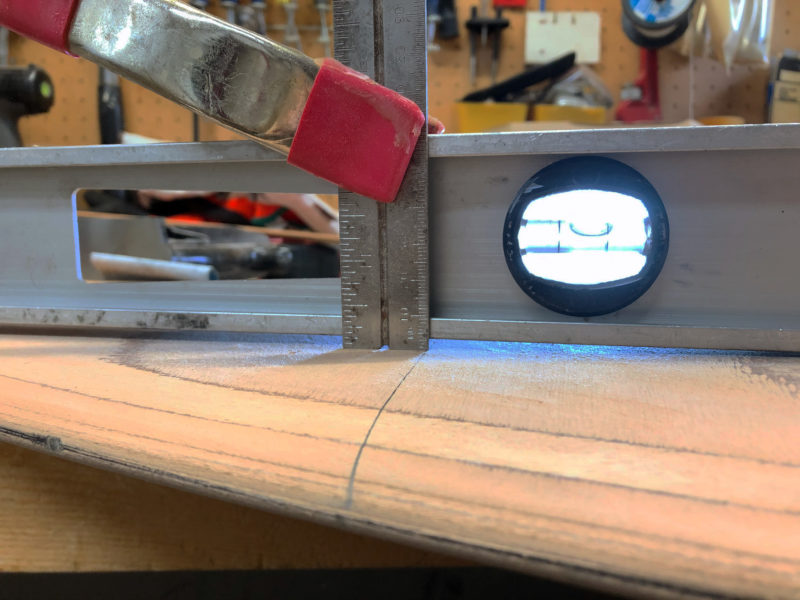
Clamping a 4′ level to the flat part of the rudder blade provides a reference line to gauge how much wood to remove to achieve the foil’s taper.
The next step is to taper the thickness of the laminated foil blank along its full length. Knowing the required thickness at your chosen points, you can draw a pattern for the curve of the taper and half the thickness of the blade stock and measure how much wood you have to remove at each point. I clamped my 4′ aluminum I-beam level to the flat part of the rudder blade above the shaped part, and used a ruler to measure the depth I had to cut to. To remove the wood for this part of the project, I used my #4 Stanley plane. While I have a power hand planer, I didn’t trust myself with it to not take too much off too quickly.
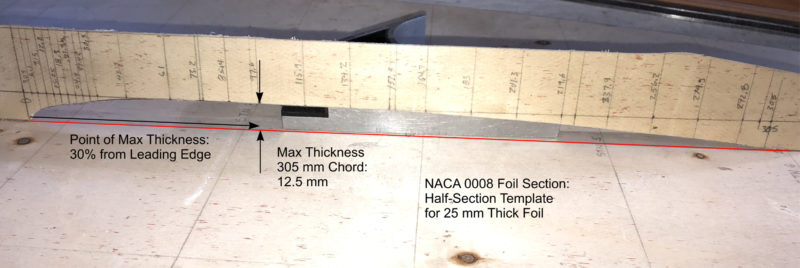
The female half-section template for a given chord for a foil gets its shape from the X-Y coordinates generated by a foil calculator.
I made three female half-section profile templates, one for each of the three points noted above, by plotting out the generated X-Y coordinates on pieces of doorskin and carefully cutting them out. One thing to note is that the CCI calculator generates a profile that has a trailing edge of zero thickness. Obviously, this is not practical to build in wood, and a knife edge is not that critical anyway. I adjusted the trailing edges so that the finished edge would end up about 1/3″ (4mm) thick.
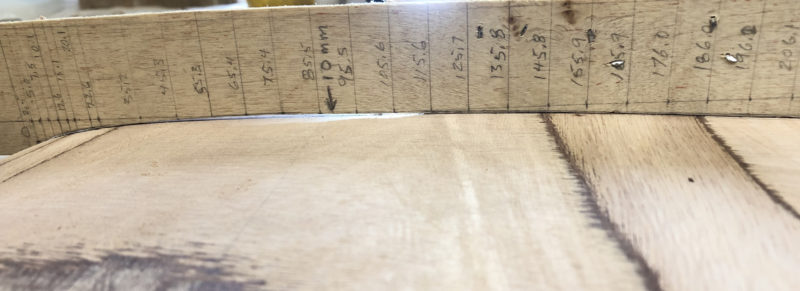
Applying the template to the foil in the works shows the high and low spots as the shaping continues.
Next, I used the profile templates to shape the foil at my three chosen points. I shaped the plywood with a Shinto rasp , regular rasps, and coarse sandpaper. It’s a process of taking some wood off, placing the template, and repeating until you get the section of wood shaped to the templates. Once that is done, I could go to work taking down the wood between the sections, using the ply layers as a guide. I used my block plane, Shinto rasp, and sandpaper for this task. I eyeballed a smooth transition around the tip from the leading edge to the trailing edge.
I sealed the surface of the shaped foil with a couple of coats of epoxy to provide a smooth, hard surface to accept a finish coat of marine epoxy enamel.
Alex Zimmerman is a semi-retired mechanical technologist and former executive. His first boat was an abandoned Chestnut canoe that he fixed up as a teenager and paddled on the waterways of eastern Manitoba and northwestern Ontario. He started his professional career as a maritime engineer in the Canadian Navy, and that triggered his interest in sailing. He didn’t get back into boatbuilding until he moved back to Vancouver Island in the ’90s, where he built a number of sea kayaks that he used to explore the coast. He built his first sail-and-oar boat in the early 2000s and completed his most recent one in 2016. He says he can stop building boats anytime. He is the author of the recently published book, Becoming Coastal .
For further reading on the pros and cons of the variables in foil design, Competition Composites (CCI) has a good discussion . For those of you who want to go into the math, Paul Zander has a good presentation from nearly 20 years ago, and also, for those inclined that way, an updated discussion with a lot more math.
You can share your tips and tricks of the trade with other Small Boats Magazine readers by sending us an email .
Share this article
Join The Conversation
We welcome your comments about this article. If you’d like to include a photo or a video with your comment, please email the file or link.
Comments (17)
Is there someone who can craft a good rudder for my boat? I have not the time or the skills to do such. Have a 15′ Delaware Ducker. Love the boat but the rudder is (I think) a disaster. Hardly brings the boat around and doesn’t help much to windward. Flat plywood barn door out of 3/8″ ply with no shape other than outline that barely gets 2″ – 3″ into the water. If it could be a kick-up so much the better. I do a lot of shallow, sand-bottom sailing. Thank you for any help.
I know about the ducker and a foil shaped rudder will help a lot. Some of the modern ones built in glass and cold molded have been fitted with modern dinghy rudders and foil shaped daggerboards. They tack more like a dinghy than like my traditional one where I have to sail it around like a larger boat.
Most any small boat builder in your area should be able to build you a rudder. Lines for a kick up would be a nuisance. I don’t bother with them on a larger boat, just use a pivot bolt with tension. Means I have to shove it down.
You might want to look at the system that Mike Storer has developed for his goat island skiff, a straight foil, easier to shape.
Alex has done a great idea showing us how to work these out using hand tools. We used to do it in my dinghy sailing days by drawing a 30 % line. Make a bunch of parabola templates and hack away. For really long narrow boards before the days of carbon we used to use 5/4 stair tread fir.
Interesting article. When I built my Oughtred JII Yawl eighteen years ago, I did some research on appropriate foil profiles for the centerboard and rudder. It’s a long time ago now, so I don’t remember the exact profiles I chose, but I do believe I picked NACA 0010 for the CB. I picked another profile for the rudder, one that had a steeper stall angle, on the theory that with typical weather helm the rudder meets the flow at a steeper angle than the CB. I really don’t know how valid my theory is. I have no experimental evidence to back it up. Any thoughts?
Andrew, that seems to make sense although I haven’t seen any research to back that up.
Hi Andrew, I remember seeing your beautiful JII; but did not ask about the foils! I wonder how NACA 0010 compares with my approximate foil shape, inspired mainly by guesswork. Are these profiles available? By the way, I do not like plywood foils; CBs break. Friends near here lost their fine old rebuilt Wayfarer; were in danger themselves, when they capsized and the plywood board broke. Too near a rugged lee shore. A class racing boat, by a particular builder – all their plywood centerboards broke.
Iain, I don’t know what your standard foil shape looks like, but a NACA 0010 has a maximum thickness of 10% of the chord distance, occurring at 30% of the distance back from the leading edge. Marchaj believes that the maximum thickness should occur at about 50% of the distance back from the leading edge. Other designers agree, I think. If I understand him correctly, John Welsford uses a foil section that is closer to 50% distance, but I am not sure what thickness of foils he favors or what the exact foil shape is. You can see the shape, and all the requisite numbers for extracting an X-Y plot to reproduce them, for a whole bunch of different foil types, on the Airfoil Tools site. As for plywood foils, I understand your concern. Half the plies are oriented in the wrong direction and don’t provide much in the way of resisting sideways bending moments. However, it has been my experience that this is not a major concern if the foil is thick enough and not too long. The centerboard foil on my latest boat, for example, is ply, but is nearly 2″ (50 mm) at maximum thickness. It’s got over 1,000 nautical miles in four years under the keel by now, including a couple of practice capsizes, with no issues so far.
I don’t know what a standard Wayfarer foil looks like. Is it long and thin?
Very interesting article. I am just in the process of building a Lillistone Flint and have no experience building or knowledge of foil design and performance. I calculated the various ratios and percentages. The AR as per the plans is 2.43, so that looks good. The thickness however is only 4% of chord width. Area of the dagger board is 3.5% of sail area, so probably OK there too. Lillistone does state in the plans that the board can be made thicker if preferred so I think I may do that as 4% is a pretty big departure from the 8 – 10% of the chord width suggested. Any comments? The Flint was featured in this mag a few issues ago.
David, both my experience and authorities who design for a living and/or who have tested these things would suggest that 4% is rather too thin for good lift. I suspect that you might find it works reasonably well in dead flat water but you would lose lift and pointing ability as the water gets more turbulent. If it was me, and I hadn’t yet built the foil and its case, I’d go for one that was at least 10% and maybe even 12%. The additional thickness would also be more robust should you need to stand on it to flip the boat over if you capsize.
Thanks so much for taking the time to reply, Alex. I have decided to use some salvaged King William (King Billy here in Tasmania) pine that was salvaged. I thicknessed it to clean it up a bit and reckon I will eventually get 20 – 22 mm out of it. I plan to laminate 10 pieces into a 304mm board. Hopefully I will get a good result.
Hi David, It highly depends where you sail and how you sail. I have one older (1975) 420er dinghy for fun and local competitions with foiled board and rudder. But then I have 21″ German Jollenkreuzer veteran from 1952 which has both from 1/4″ steel plate, and it works fine. I sail that for pleasure on lakes. It would definitely be more performant (and point better) with both foiled, but I’m surprised how well it performs in its nearly ’70s (comparing to modern GRP boats with foiled boards).
For your job, I would probably stick to the plans. The rudder in this case is more important and can be somehow easily modified (foil). The centerboard I would keep the same, not only to conform the centerboard box (which would need to be sized), but also the overall design. Finally the most important here is what is your building and designing experience, because the worst thing is when something is incorrectly designed and then improperly built (the simple rounded plywood then may work better).
Anyway, I’m also thankful for this article. It reminds me my childhood when I built airplane models and used exactly the same methods used here to create the wings (in much smaller scale).
Thanks for your thoughts. I am going for a thicker foil and risk it (see reply to Alex above). I am well aware of risks in departing from designer’s work but I don’t think I will go far wrong.
Do SUP fins follow the rules for centerboards?
I’m not a SUP guy myself, but my understanding is that the fins are there to assist in tracking. That is, they don’t need to provide lift the way a sailboat keel/CB going to windward does. The thing you would be aiming for in the case of SUP fins is having sufficient lateral area to provide that tracking ability, and then having it streamlined to reduce drag. I would imagine that thinner would be better, although you’d still want a streamlined foil section, as that would produce less drag than a flat plate. The leading edge of a flat plate tends to separate the flow from the sides of the plate, even if that edge is rounded, and separation produces turbulence and drag.
For twenty years, beginning in the early 1970’s, I raced a Lido 14. The boat was pre-owned, and had its original solid wood foils which were in pretty bad shape, and I decided to build new foils. After reading Marchaj’s book, and the Lido 14 Class Rules, I designed a new centerboard and rudder. The NACA-0009 section most closely fit the required class measurements, and I used that profile. I did alter the leading edge of the rudder, making it more rounded, to allow for the fact that the rudder angle of attack is variable, and is more likely to stall.
In fleet racing, and sailing close hauled, the results were astounding, with the boat seeming to sail slightly sideways, relative to other boats. I also began to pay particular attention to the condition of the foil surfaces, as Marchaj writes that the drag on underwater foils is many times greater than the drag on the hull surface. One time we were sailing in an area of submerged trees, and my centerboard lightly brushed a tree branch. I then noticed that the centerboard ‘hummed’ on port tack. Later, when I examined to board, there was a barely visible scratch.
I very much enjoyed the article on high-performance foils in the July 2020 issue of the Small Boat Magazine .
For twenty years, beginning in the early 1970’s, I raced a Lido 14. The boat was pre-owned, and had its original solid wood foils which were in pretty bad shape, and I decided to build new foils. After reading Marchaj’s book, and the Lido 14 Class Rules, I designed a new centerboard, and rudder. The NACA-0009 section most closely fit the required class measurements, and I used that profile. I did alter the leading edge of the rudder, making it more rounded, to allow for the fact that the rudder angle of attack is variable, and is more likely to stall.
In fleet racing, and sailing close hauled, the results were astounding, with the boat seeming to sail slightly sideways to windward, relative to other boats. The boat didn’t seem to point higher, when close hauled, it just didn’t make as much lee way. More benefit on the port tack, a little less on starboard. I did set the centerboard jibe angle to the maximum allowed by class rules. In all honesty, I was probably the only one in the fleet that had read Marchaj. It still took me five years to win the fleet championship. I also began to pay particular attention to the condition of the foil surfaces, as Marchaj writes that the drag on underwater foils is many times greater than the drag on the hull surface. One time we were sailing in an area of submerged trees, and my centerboard lightly brushed a tree branch. I then noticed that the centerboard ‘hummed’ on port tack. Later, when I examined to board, there was a barely visible scratch.
I am a new subscriber to Small Boat Magazine , and look forward to each issue. Keep up the good work.
Was just about to make the centerboard for my Oughted Caledonia Yawl. So I was happy to see this article. But was then disappointed when I calculated my centerboard area to be only 1.9 percent of my total sail area. I briefly thought gee I will make it a little bigger…but then realized the centerboard trunk is already complete and limits that. I don’t plan on racing, so it is what it is.
Mark, I’d be really interested in your results once you launch the boat and do some trials. Theory is one thing, but nothing beats data from real-world results.
Leave a Reply Cancel reply
Your email address will not be published. Required fields are marked *
Stay On Course
More From This Issue
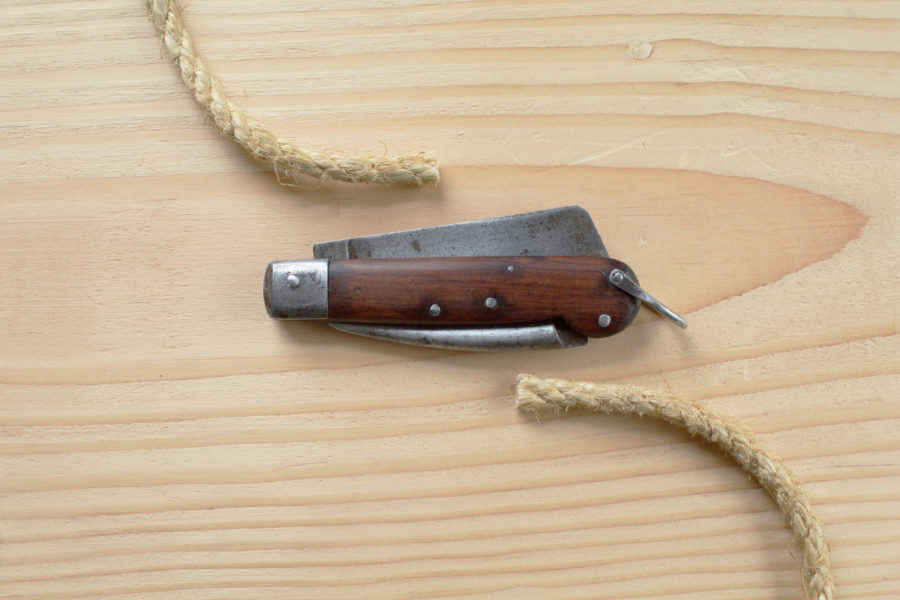
From The Editor
Lost and Found
I have a shelf in the corner of my shop where I pile my collection of tape measures. They frequently fall off the shelf, and this past week I got…
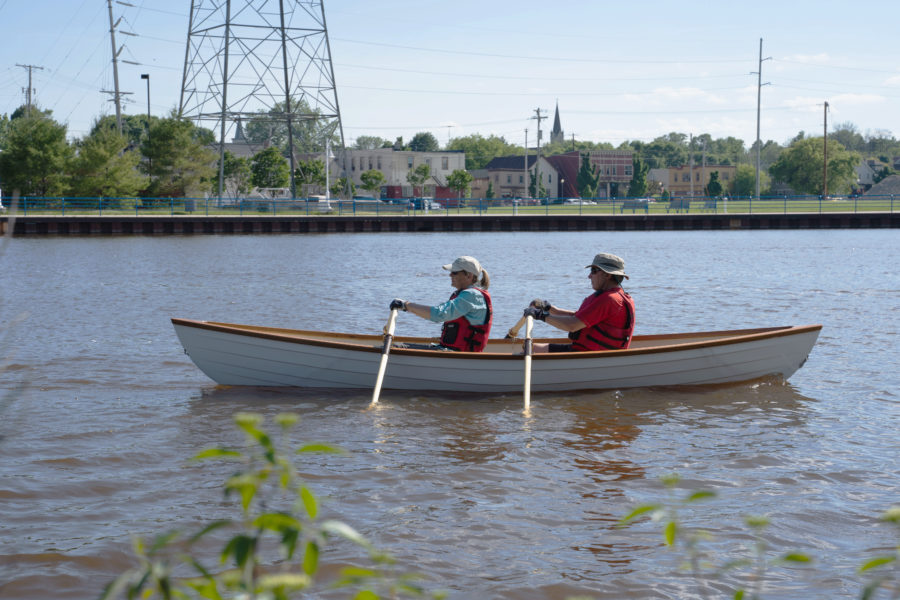
Boat Profile

Crawford’s Gunning Dory
Roger builds his boats one at a time. The Gunning Dory is hand-laid fiberglass starting with rolled-on gelcoat. The layup for the bottom includes biaxial fiberglass cloth, a 1/2″ foam…
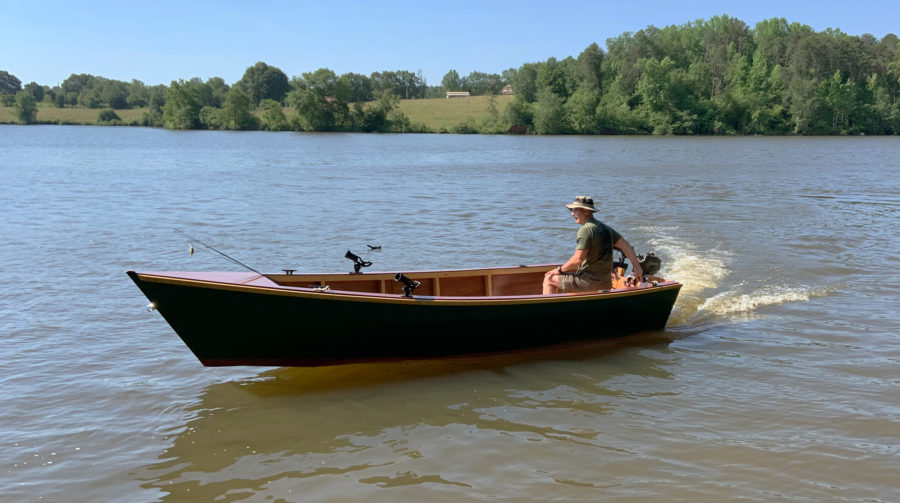
Spira’s Hudson Skiff
I have a full-sized pickup truck, so trailering the lightweight skiff is not at all difficult. Launching at the ramp is similarly not a problem; Hudson floated right off the…
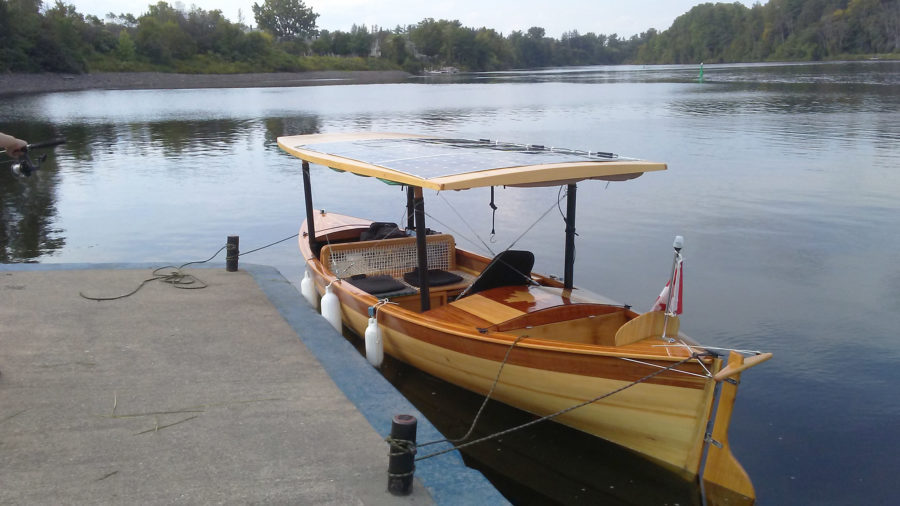
A Solar Solo
SOL CANADA had been performing fairly well, but about once an hour the motor would just stop. I could get it going again by putting the throttle neutral for a…
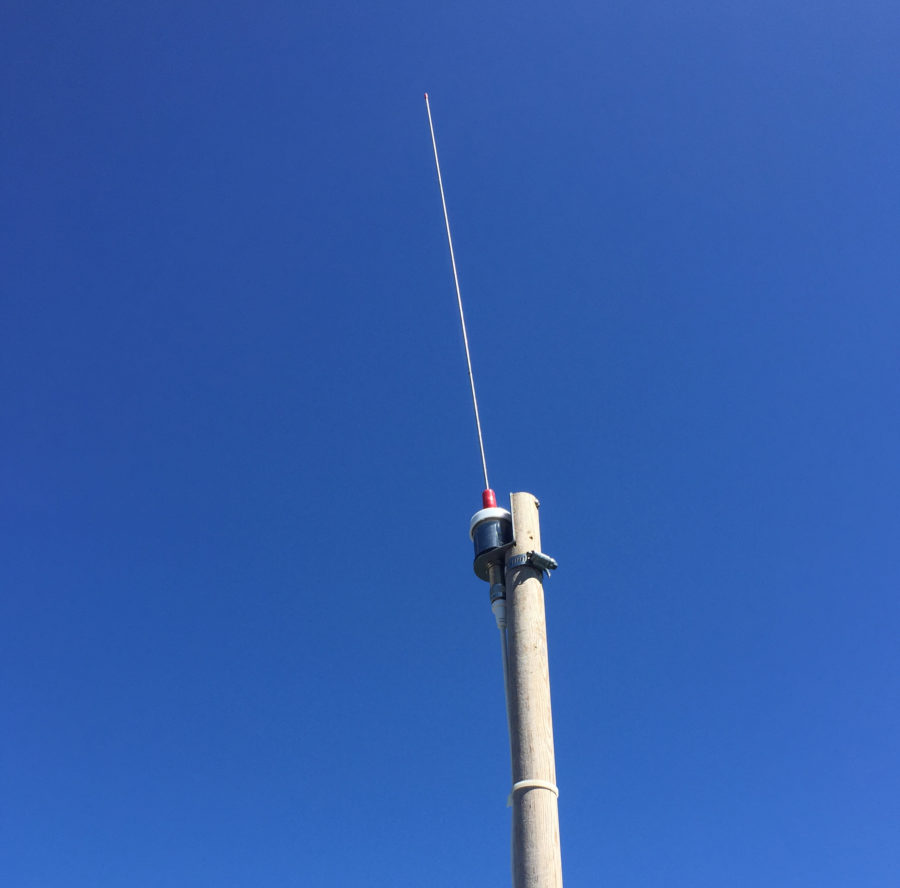
Antennas for VHF
VHF radios, like cell phones, are limited to line of sight. The Coast Guard sets its antennas up as high as possible, often in spots remote from their base, to…
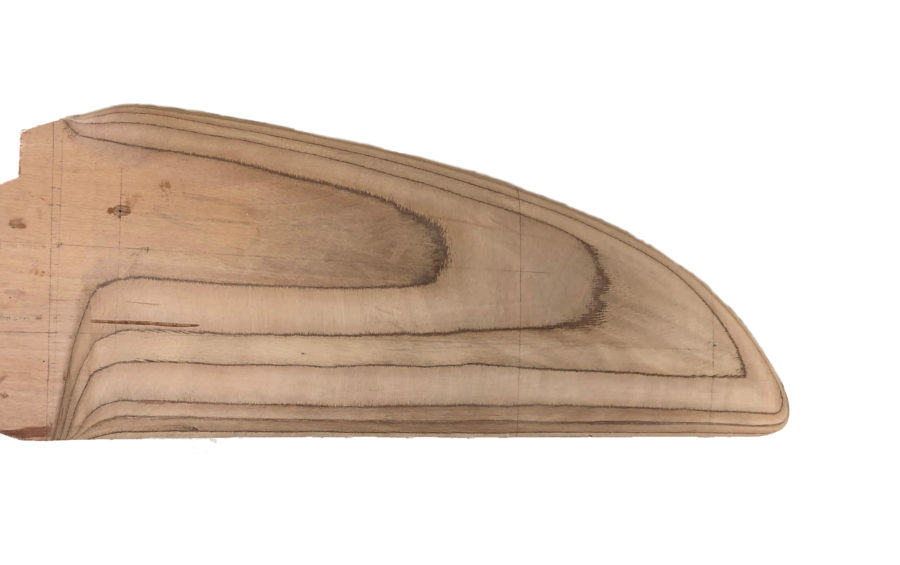
I made a blank for my rudder by gluing layers of marine ply with epoxy to the required 1″ thickness. I have found that the plywood, in spite of its…
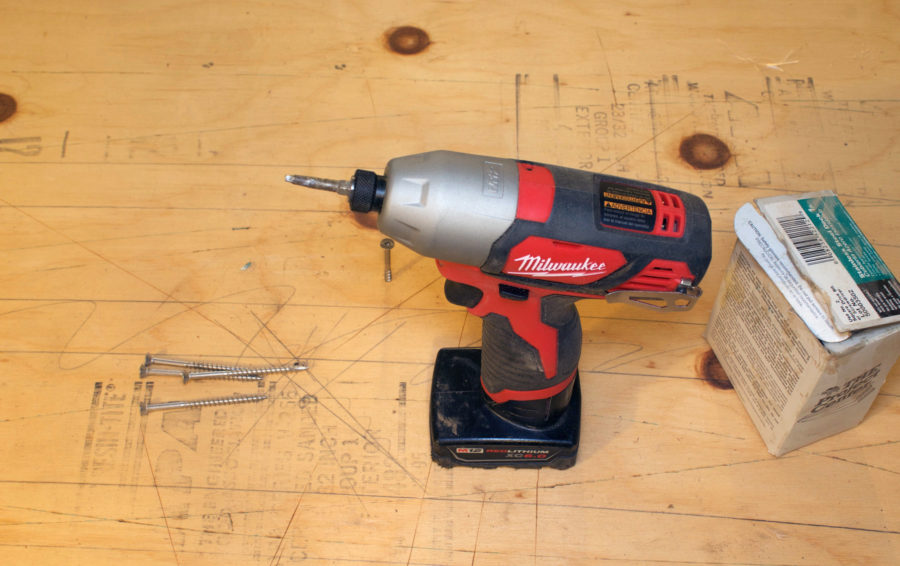
Product Reviews
Impact Drivers
While the impact driver has lots of power, more than enough to shear screws, the variable-speed trigger provides the operator with very good control for the depth of the screw.…
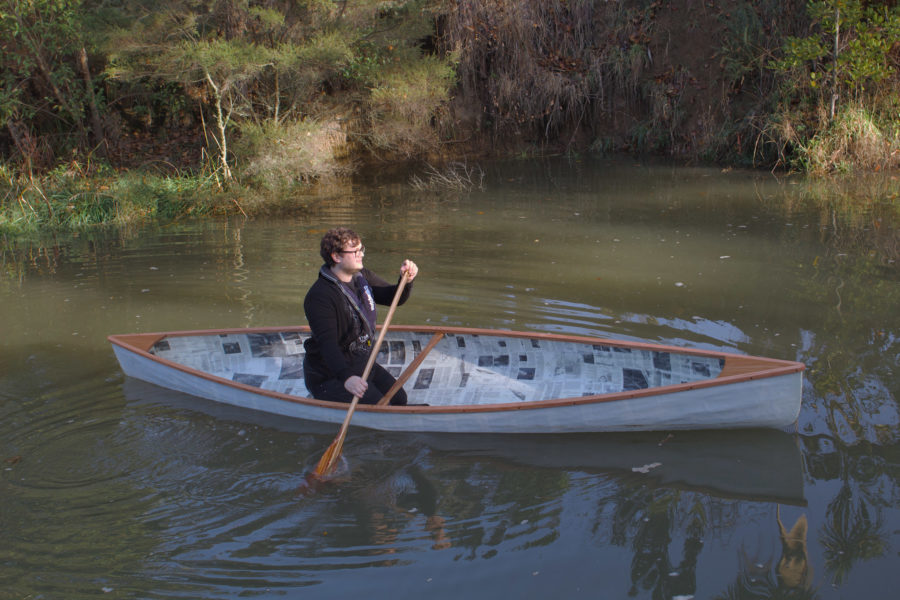
Reader Built Boats
Built by the Book
The lockdown in New Zealand began on March 23 and David stayed home to do his part in slowing the spread of COVID-19. He focused on his canoe projects and…
More Technique
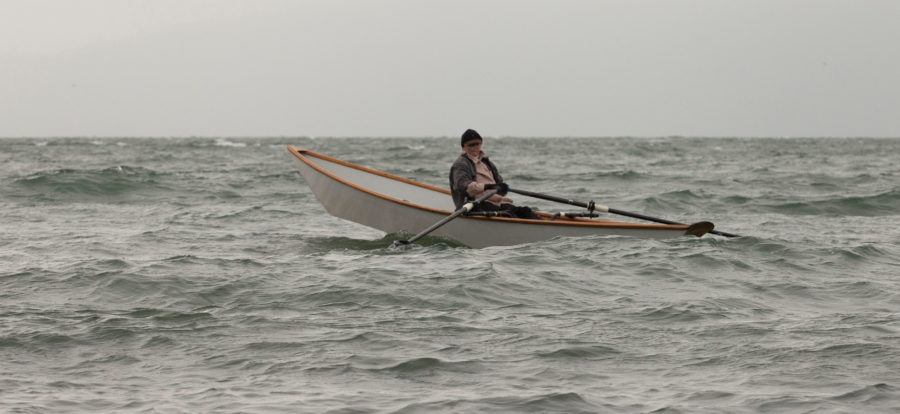
Rowing Rough Water
Sailors want wind; rowers don’t. Rough water can be a challenge to a rower’s skills, but I’ve found a few techniques that can help you reach a safe haven when…
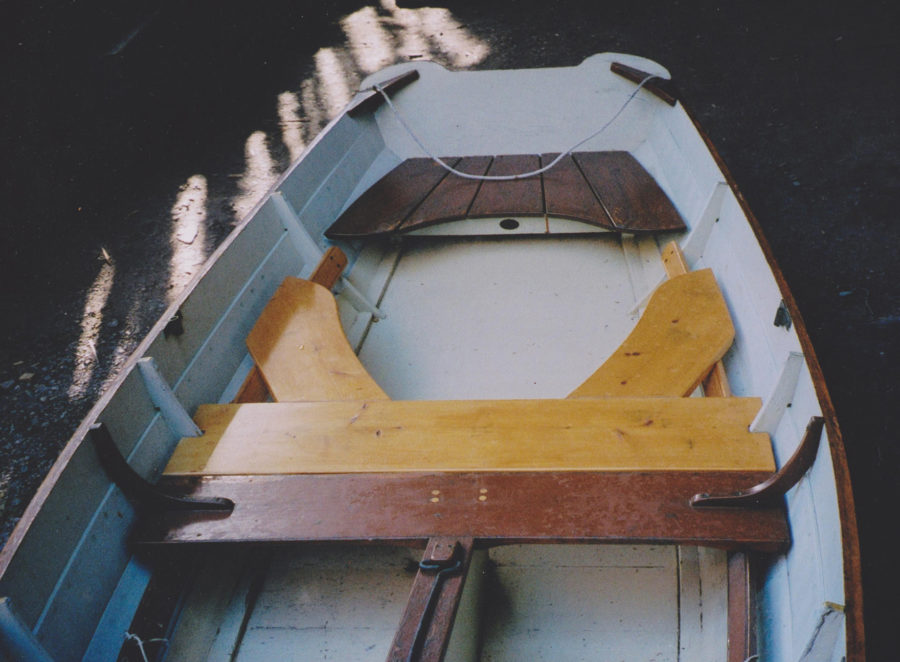
Comfortable Seating for Sailing a Small Rowing-and-Sailing Skiff
As age makes its inevitable changes to the sailor’s once supple joints, certain positions that were once assumed without thought become uncomfortable, if not actually painful. When I was younger…
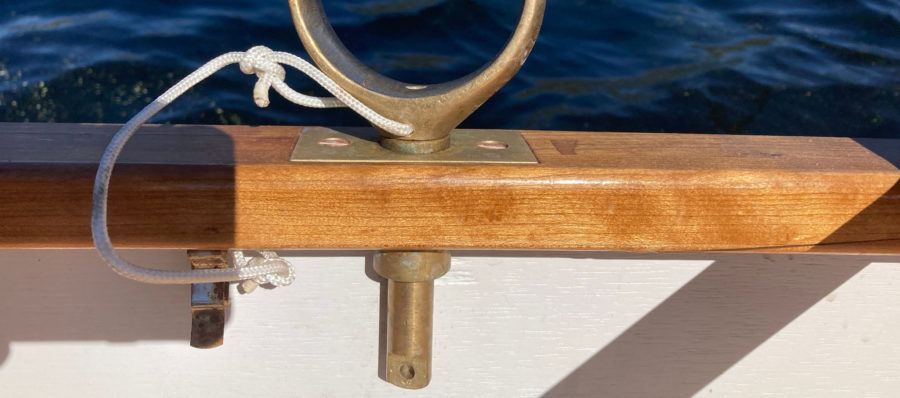
DIY Oarlock Sockets
The secret ingredient is a $6 Oilite bushing. Oilite is sintered oil-impregnated bronze: powdered metal coalesced into a porous solid, permanently holding lubricant in its interstices. In use, oil travels…

A DIY Cagoule
I lost track of my original cagoule, so I recently re-created a pattern and sewed up two new cagoules. The first was a bit tight over my knees when I…
Subscribe Today!
Become a subscriber today and you’ll recieve a new issue every month plus unlimited access to our full archive of backlogged issues.
Already a subscriber? Sign In
Subscribe For Full Access
Flipbooks are available to paid subscribers only. Subscribe now or log in for access.

- Subscribe Now
- Digital Editions

Best hydrofoil boats: 6 of the most spectacular foiling motorboats money can buy
- Electric boats
- Top stories
Foiling technology has really taken off in the past few years. We pick out 6 of the best hydrofoil boats you can buy right now…
With its roots in the 19th century, foiling technology is as old as the hills, but in the past five years we’ve noticed an explosion of hydrofoil boats coming onto the market.
In part inspired by the foiling raceboats of the America’s Cup , the popularity of foiling is easy to understand – fuel efficiency gains are substantial, noise is almost eliminated (particularly if your foiling boat also happens to be an electric boat ) and they look as cool as a snowman in a freezer!
To help you understand the dizzying array of foiling boats available right now, we’ve put together the following guide to what we think are the most promising designs out there.
6 of the best hydrofoil boats

SEAir foiling RIB
Founded in 2016, French yard SEAir builds foiling RIBs, having been inspired by the speed of foiling racing yachts.
We tested their 5.5m model back in 2018 and since then they have expanded their range to cover superyacht chase boats, commercial and military vessels.
Our tester recorded a top speed of 32 knots, with the foils doing their best work at around 20 knots, but SEAir claims that 42 knots is possible in the right conditions.
Read more about the SEAir foiling RIB
Article continues below…
Spirit Yachts launches spectacular long-range electric flying boat
Bmw launches new icon electric boat at cannes film festival.
The Cannes Film Festival has seen the launch of the new ICON electric boat. Created by BMW in collaboration with

A dual helm set-up allows the boat to be piloted from the bow or the cockpit. Photo: Guillaume Plisson
Enata Foiler
Dubai-based Enata Marine added a healthy dose of glamour to the world of foiling boats in 2018 with the launch of its Foiler.
In addition to a superyacht tender-worthy exterior, this 32fter includes a bow window for spectacular views while underway.
A 40-knot top speed and a 190nm range makes this a very appealing option, although the premium price tag of $938,000 may put some off.
Read more about the Enata Foiler

Princess R35
When British boatbuilding giant Princess Yachts got in on the foiling boat game in 2019 with a 35ft carbon-fibre dayboat, we knew that things had really taken off.
While the foil-assisted R35 may not have the spectacular cruising-above-the-waves appeal of some other foiling boats, it is highly efficient, beautifully designed (in collaboration with Pininfarina) and handles like nothing else we’ve ever driven.
In our review, we praised its rare combination of agility, refinement and stability, with spray kept in check impressively at high speeds.
Read more about the Princess R35

The foiling Candela C-8 is the first boat to use Candela’s proprietary C-POD, but bigger craft will follow later
Candela C-8
Swedish firm Candela burst onto the scene in 2021 with its debut, the Candela C-7 , which was billed as the world’s first electric foiling boat, but it was the 2022 launch of the Candela C-8 that really moved the game on.
Available with a 69kWh battery, adapted from the Polestar 2 electric car, owners can expect a range of 57nm at 22 knots, more than enough for dayboat use.
The consumption figures are truly staggering, with Candela’s figures suggesting that the C-8 is more than 12x more efficient than an equivalent 300hp outboard powered sportsboat.
Read more about the Candela C-8

The electric Iguana is capable of three knots on the land and 30 knots at sea
Iguana Foiler
Not content with being at the forefront of the amphibious boats market with its caterpillar-track offering, French yard Iguana has set its sights on the world of foiling too.
Announced last year, the Iguana Foiler will be powered by the world’s most powerful electric outboard engine, the 300hp Evoy Storm .
Having tested both the engine and the boat separately, we can’t wait to see the result when they come together with the added advantages of foiling technology. Watch this space…
Read more about the Iguana Foiler

The foils lift up at slow speeds to reduce the draft
Mantaray M24
Another exciting model in the hydrofoil boats pipeline, this 24ft runabout is particularly interesting is its simplicity. Unlike its main foiling rival, the Candela C-7, the Mantaray M24 requires no complicated electronics to ‘fly’.
Instead it uses the builder’s patented mechanical hydrofoil system, which it has trademarked as Dynamic Wing Technology or DWT. The technology is said to be the result of ten years’ development work and uses a retractable T-foil in the bow and H-foil amidships that self-stabilise mechanically.
This allows it to lean naturally into corners and ride serenely over waves without relying on a network of sensors and algorithms to monitor and adjust the foils. If it proves effective this could drastically reduce the cost and complexity of foiling boats, while simultaneously increasing reliability.
Read more about the Mantaray M24
It doesn’t end here, with fascinating one-off projects from Spirit Yachts and BMW on the water, it’s clear that foiling has a huge potential for transforming the world of boating.
Read more about hydrofoil technology
Arksen 85 Explorer tour: The ultimate long-range cruiser
Mayla gt tour: ‘100+ knot’ speed machine with outrageous looks, circumnavigating great britain in an 18ft speedboat: spotting whales on the irish coast, latest videos, sacs rebel 50 tour: the world’s most luxurious rib, fairline targa tour: sensational new british sportscruiser, navan s30 & c30 tour: exceptional new axopar rival.
- AROUND THE SAILING WORLD
- BOAT OF THE YEAR
- Email Newsletters
- America’s Cup
- St. Petersburg
- Caribbean Championship
- Boating Safety

Best Dinghy: UFO Foiler
- By Dave Reed
- Updated: December 19, 2017
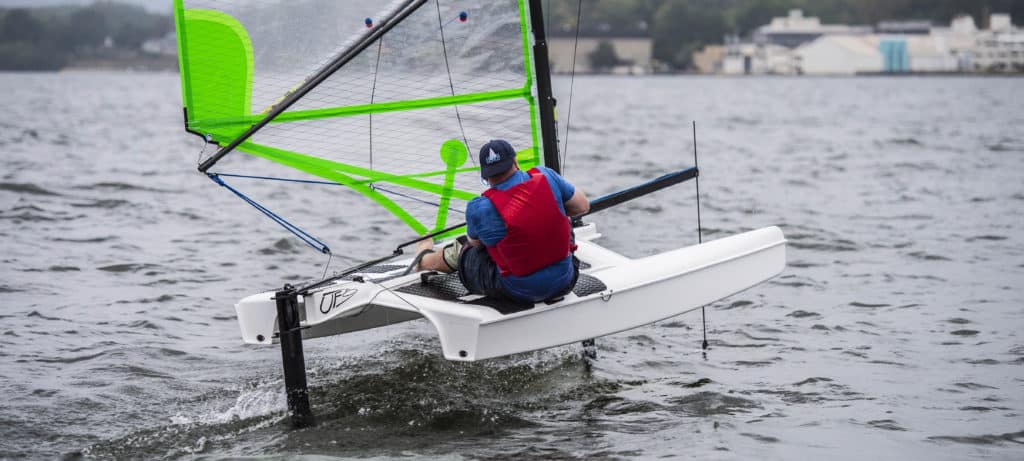
As a unique foiling object, indeed the UFO’s most appealing aspect is the ability to sail it in conditions that have other foilers on the beach. Sailors new to foiling will be quickly rewarded with minimal effort.
Dave Clark is the UFO’s co-creator, builder, tweaker and apostle. When he explains the construction of his 10-foot catamaran contraption (“we use this apocalyptically thick triaxial fiberglass layup”) and its handling (“as you ask the boat to challenge you, it will continue to challenge you, but only when it’s asked”), his enthusiasm is as animated as the UFO’s behavior on the water, especially in flight. The UFO is otherworldly, the judges agree, with the potential to disrupt the dinghy-sailing scene as an all-access low-cost foiler.
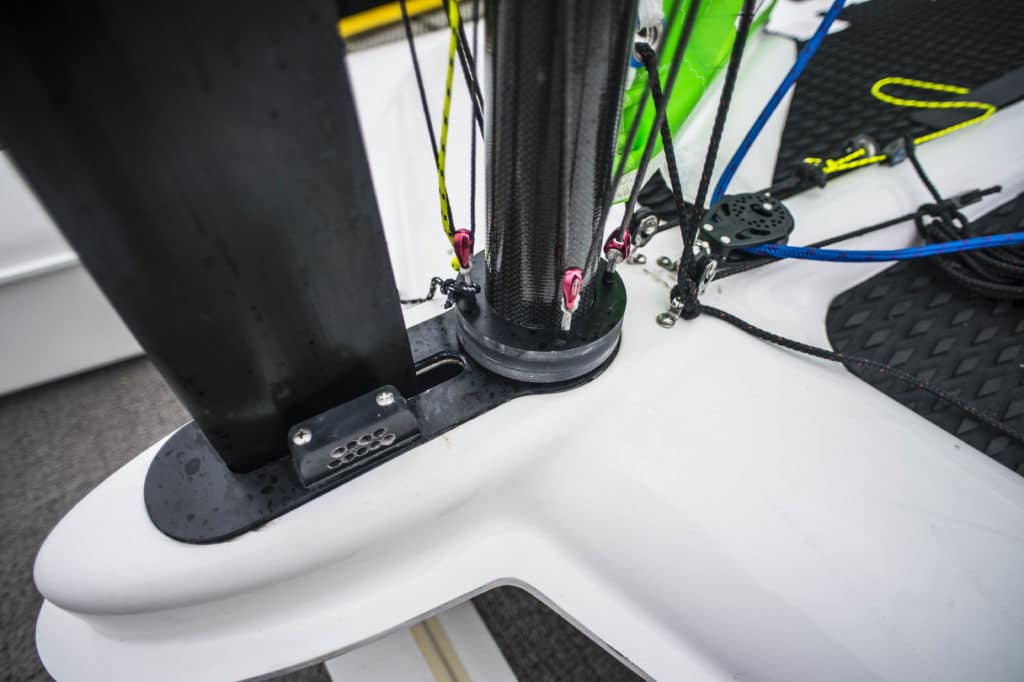
Nowadays at Clark’s Fulcrum Speedworks factory in Bristol, Rhode Island, he’s cranking out these pint-size craft, shipping batches in cardboard boxes and containers with international shipping manifests. He’s taking orders over the phone, on credit cards, from impulse buyers dropping $7,600 for an “all-inclusive” sailing experience.
How’s the UFO built? It’s vacuum-infused, with carbon-reinforced vinylester for an all-up weight of 110 pounds. The wishbone spar assembly is a mix of carbon and fiberglass components; the foil struts are extruded aluminum; and the elevators are a mix of carbon, glass, foam core and stainless-steel parts.
“Complexity is the enemy,” says Clark, who developed the UFO with his father, Steve Clark. “I need it to be robust, and I can’t have parts go missing.”
That might be true of the UFO’s big pieces, says Allen, but there are still quite a few little pins and parts required for assembly and flight. “You’ll have to take good care of it, especially if you’re in and out of the water, and moving it around all the time.”
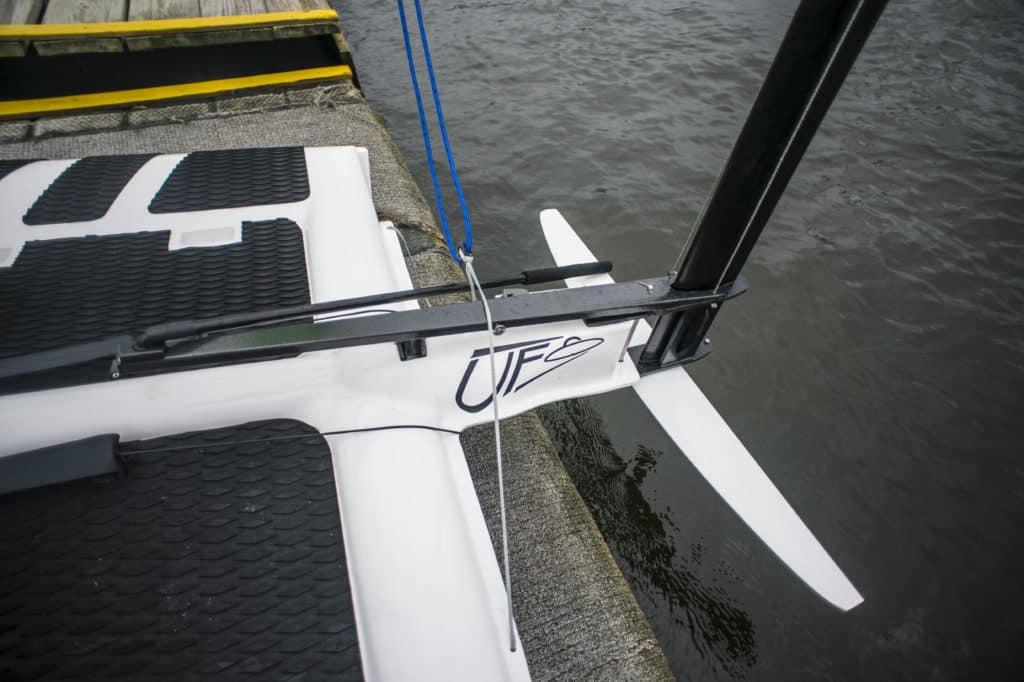
The carbon windsurfing mast tube that Clark uses is bendy, so he added a jumper strut system to stiffen it. The wishbone arrangement is then the most effective way to provide high leech tension and power in the sail, which is essential to the entire rig package.
The judges’ testing session in sub-8-knot conditions doesn’t allow flight for Tom Rich nor Greg Stewart, both of whom exceed 200 pounds. But Clark, at 170 pounds and with two years in the boat, has it foiling in a heartbeat, using an explosive kinetic technique he’s perfected to get liftoff. Allen is initially unable to get it foil-borne, but 2 knots more of windspeed and a little extra effort on the mainsheet is all it takes to get him flying.
The UFO’s tunnel hull is a simple and defining platform that allows it to be sailed home when the breeze gets to be too little or too much. Its T-Foils lift nearly flush with the bottom of the boat, for launching it from a shoreline or a dock. The ride-height wand is easily adjustable to the desired challenge of the day. “Low to start and learn,” says Clark. “Higher as you get better and faster.”
At the end of your UFO session, break it down and leave it on a dolly, or stuff the whole lot into your family wagon.
“That’s what makes this boat so cool,” says Allen. “It’s innovative, creative and inexpensive. I can see a lot people getting their first taste of foiling with this thing.”
Or as Clark pontificates, “You can use it across your entire sailing career — from your Opti until you’re old and dead.”
At a Glance
To watch video of the UFO in action, click here . To read more about the genesis of the UFO, click here .
- More: Boat of the Year , Boat of the Year 2018 , foiling , Fulcrum Speedworks , new boats , News , Sailboats , ufo
- More Sailboats

Nautor Swan Has A New Pocket Rocket

Pogo Launches its Latest Coastal Rocket

A Deeper Dive Into the Storm 18

2024 Boat of the Year Best Recreational Racer: Z24

Terhune’s Take On A Winning Streak

How the Hobart Was Won

Into the Dink

Sally Helme, Marine Industry Icon Passes

- Digital Edition
- Customer Service
- Privacy Policy
- Cruising World
- Sailing World
- Salt Water Sportsman
- Sport Fishing
- Wakeboarding

10 Best Small Sailboats (Under 20 Feet)

Last Updated by
Daniel Wade
December 28, 2023
Compact, easy to trailer, simple to rig, easy to maintain and manage, and affordable, the best small boats all have one thing in common: they offer loads of fun while out there on the water.
So whether you're on a budget or just looking for something that can offer ultimate daytime rides without compromising on safety, aesthetic sensibilities, alternate propulsion, and speed, the best small sailboats under 20 feet should be the only way to go.
Let's be brutally honest here; not everyone needs a 30-foot sailboat to go sailing. They come with lots of features such as electronics, entertainment, refrigeration, bunks, a galley, and even a head. But do you really need all these features to go sailing? We don't think so.
All you need to go sailing is a hull, a mast, rudder, and, of course, a sail. And whether you refer to them as daysailers, trailerable sailboats , a weekender sailboat, or pocket cruisers, there's no better way to enjoy the thrills of coastal sailing than on small sailboats.
There are a wide range of small boats measuring less than 20 feet available in the market. These are hot products in the market given that they offer immense thrills out on the sea without the commitment required to cruise on a 30-footer. A small sailboat will not only give you the feel of every breeze but will also give you the chance to instantly sense every change in trim.
In this article, we'll highlight 10 best small sailboats under 20 feet . Most models in this list are time-tested, easy to rig, simple to sail, extremely fun, and perfect either for solo sailing or for sailing with friends and family. So if you've been looking for a list of some of the best small sailboats , you've come to the right place.
So without further ado, let's roll on.
Table of contents
{{boat-info="/boats/hunter-15"}}
The Marlow-Hunter 15 is not only easy to own since it's one of the most affordable small sailboats but also lots of fun to sail. This is a safe and versatile sailboat for everyone. Whether you're sailing with your family or as a greenhorn, you'll love the Hunter 15 thanks to its raised boom, high freeboard, and sturdy FRP construction.
With high sides, a comfortable wide beam, a contoured self-bailing cockpit, and fiberglass construction, the Hunter 15 is certainly designed with the novice sailor in mind. This is why you can do a lot with this boat without falling out, breaking it, or capsizing. Its contoured self-baiting cockpit will enable you to find a fast exit while its wide beam will keep it steady and stable no matter what jibes or weight shifts happen along the way.
This is a small sailboat that can hold up to four people. It's designed to give you a confident feeling and peace of mind even when sailing with kids. It's easy to trailer, easy to rig, and easy to launch. With a price tag of about $10k, the Hunter 15 is a fun, affordable, and versatile boat that is perfect for both seasoned sailors and novices. It's a low-maintenance sailboat that can be great for teaching kids a thing or two about sailing.
Catalina 16.5
{{boat-info="/boats/catalina-16-5"}}
Catalina Yachts are synonymous with bigger boats but they have some great and smaller boats too such as Catalina 16.5. This is one of the best small sailboats that are ideal for family outings given that it has a big and roomy cockpit, as well as a large storage locker. Designed with a hand-laminated fiberglass sloop, the Catalina 16.5 is versatile and is available in two designs: the centerboard model and the keel model.
The centerboard model is designed with a powerful sailplane that remains balanced as a result of the fiberglass centerboard, the stable hull form, and the rudder. It also comes with a tiller extension, adjustable hiking straps, and adjustable overhaul. It's important to note that these are standard equipment in the two models.
As far as the keel model is concerned, this is designed with a high aspect keel as the cast lead and is attached with stainless steel keel bolts, which makes this model perfect for mooring or docking whenever it's not in use. In essence, the centerboard model is perfect if you'll store it in a trailer while the keel model can remain at the dock.
All in all, the Catalina 16.5 is one of the best small sailboats that you can get your hands on for as low as $10,000. This is certainly a great example of exactly what a daysailer should be.
{{boat-info="/boats/hobie-16"}}
There's no list of small, trailerable, and fun sailboats that can be complete without the inclusion of the classic Hobie 16. This is a durable design that has been around and diligently graced various waters across the globe since its debut way back in 1969 in Southern California. In addition to being durable, the Hobie 16 is trailerable, great for speed, weighs only 320 pounds, great for four people, and more importantly, offers absolute fun.
With a remarkable figure of over 100,000 launched since its debut, it's easy to see that the Hobie 16 is highly popular. Part of this popularity comes from its asymmetric fiberglass-and-foam sandwiched hulls that include kick-up rudders. This is a great feature that allows it to sail up to the beach.
For about $12,000, the Hobie 16 will provide you with endless fun throughout the summer. It's equipped with a spinnaker, trailer, and douse kit. This is a high-speed sailboat that has a large trampoline to offer lots of space not just for your feet but also to hand off the double trapezes.
Montgomery 17
{{boat-info="/boats/montgomery-17"}}
Popularly known as the M-17, The Montgomery 17 was designed by Lyle C. Hess in conjunction with Jerry Montgomery in Ontario, California for Montgomery Boats. Designed either with keel or centerboard models, the M-17 is more stable than most boats of her size. This boat is small enough to be trailered but also capable of doing moderate offshore passages.
This small sailboat is designed with a masthead and toe rail that can fit most foresails. It also has enough space for two thanks to its cuddly cabin, which offers a sitting headroom, a portable toilet, a pair of bunks, a DC power, and optional shore, and a proper amount of storage. That's not all; you can easily raise the deck-stepped mast using a four-part tackle.
In terms of performance, the M-17 is one of the giant-killers out there. This is a small sailboat that will excel in the extremes and make its way past larger boats such as the Catalina 22. It glides along beautifully and is a dog in light air, though it won't sail against a 25-knot wind, which can be frustrating. Other than that, the Montgomery 17 is a great small sailboat that can be yours for about $14,000.
Norseboat 17.5
{{boat-info="/boats/norseboat-17-5"}}
As a versatile daysailer, Norseboat 17.5 follows a simple concept of seaworthiness and high-performance. This small sailboat perfectly combines both contemporary construction and traditional aesthetics. Imagine a sailboat that calls itself the "Swiss Army Knife of Boats!" Well, this is a boat that can sail and row equally well.
Whether you're stepping down from a larger cruiser or stepping up from a sea kayak, the unique Norseboat 17.5 is balanced, attractive, and salty. It has curvaceous wishbone gaff, it is saucy, and has a stubby bow-sprit that makes it attractive to the eyes. In addition to her beauty, the Norseboat 17.5 offers an energy-pinching challenge, is self-sufficient, and offers more than what you're used to.
This is a small, lightweight, low-maintenance sailboat that offers a ticket to both sailing and rowing adventures all at the same time. At about 400 pounds, it's very portable and highly convenient. Its mainsails may look small but you'll be surprised at how the boat is responsive to it. With a $12,500 price tag, this is a good small sailboat that offers you the versatility to either row or sail.
{{boat-info="/boats/sage-marine-sage-17"}}
If you've been looking for a pocket cruiser that inspires confidence, especially in shoal water, look no further than the Sage 17. Designed by Jerry Montgomery in 2009, the Sage 17 is stable and should heel to 10 degrees while stiffening up. And because you want to feel secure while sailing, stability is an integral feature of the Sage 17.
This is a sailboat that will remain solid and stable no matter which part of the boat you stand on. Its cabin roof and the balsa-cored carbon-fiber deck are so strong that the mast doesn't require any form of compression post. The self-draining cockpit is long enough and capable of sleeping at 6 feet 6 inches.
The Sage 17 may be expensive at $25k but is a true sea warrior that's worth look at. This is a boat that will not only serve you right but will also turn heads at the marina.
{{boat-info="/boats/laserperformance-laser-sb3"}}
Having been chosen as the overall boat of the year for 2008 by the Sailing World Magazine, the Laser SB3 is one of the coolest boats you'll ever encounter. When sailing upwind, this boat will lock into the groove while its absolute simplicity is legendary. In terms of downwind sailing, having this boat will be a dream come true while it remains incredibly stable even at extraordinary speed.
Since its debut in 2004, the Laser SB3 has surged in terms of popularity thanks to the fact that it's designed to put all the controls at your fingertips. In addition to a lightweight mast, its T- bulb keel can be hauled and launched painlessly. For about $18,000, the Laser SB3 ushers you into the world of sports sailing and what it feels to own and use a sports boat.
{{boat-info="/boats/fareast-18"}}
As a manufacturer, Fareast is a Chinese boat manufacturer that has been around for less than two decades. But even with that, the Fareast 18 remains a very capable cruiser-racer that will take your sailing to the next level. In addition to its good looks, this boat comes with a retractable keel with ballast bulb, a powerful rig, and an enclosed cabin.
Its narrow design with a closed stern may be rare in sailboats of this size, but that's not a problem for the Fareast 18. This design not only emphasizes speed but also makes it a lot easier to maintain this boat. Perfect for about 6 people, this boat punches above its weight. It's, however, designed to be rigged and launched by one person.
This is a relatively affordable boat. It's agile, safe, well-thought-out, well built, and very sporty.
{{boat-info="/boats/chuck-paine-paine-14"}}
If you're in the market looking for a small sailboat that offers contemporary performance with classic beauty, the Paine 14 should be your ideal option. Named after its famous designer, Chuck Paine, this boat is intentionally designed after the classic Herreshoff 12.5 both in terms of dimensions and features.
This is a lightweight design that brings forth modern fin keel and spade rudder, which makes it agile, stable, and faster. The Paine 14 is built using cold-molded wood or west epoxy. It has varnished gunnels and transoms to give it an old-time charm. To make it somehow modern, this boat is designed with a carbon mast and a modern way to attach sails so that it's ready to sail in minutes.
You can rest easy knowing that the Paine 14 will not only serve you well but will turn heads while out there.
{{boat-info="/boats/wd-schock-lido-14"}}
Many sailors will attest that their first sailing outing was in a Lido 14. This is a classic sailboat that has been around for over four decades and still proves to be a perfect match to modern small boats, especially for those still learning the ropes of sailing.
With seating for six people, the Lido 14 can be perfect for solo sailing , single-handed sailing, or if you're planning for shorthanded sailing. While new Lido 14 boats are no longer available, go for a functional used Lido 14 and you'll never regret this decision. It will serve you well and your kids will probably fall in love with sailing if Lido 14 becomes their main vessel during weekends or long summer holidays.
Bottom Line
There you have it; these are some of the best small sailboats you can go for. While there are endless small sailboats in the market, the above-described sailboat will serve you right and make you enjoy the wind.
Choose the perfect sailboat, invest in it, and go out there and have some good fun!
Related Articles
I've personally had thousands of questions about sailing and sailboats over the years. As I learn and experience sailing, and the community, I share the answers that work and make sense to me, here on Life of Sailing.
by this author
Best Sailboats
Most Recent

What Does "Sailing By The Lee" Mean?
October 3, 2023

The Best Sailing Schools And Programs: Reviews & Ratings
September 26, 2023
Important Legal Info
Lifeofsailing.com is a participant in the Amazon Services LLC Associates Program, an affiliate advertising program designed to provide a means for sites to earn advertising fees by advertising and linking to Amazon. This site also participates in other affiliate programs and is compensated for referring traffic and business to these companies.
Similar Posts

Affordable Sailboats You Can Build at Home
September 13, 2023

Best Small Sailboats With Standing Headroom

Best Bluewater Sailboats Under $50K
Popular posts.

Best Liveaboard Catamaran Sailboats

Can a Novice Sail Around the World?
Elizabeth O'Malley
June 15, 2022

4 Best Electric Outboard Motors

How Long Did It Take The Vikings To Sail To England?

10 Best Sailboat Brands (And Why)
December 20, 2023

7 Best Places To Liveaboard A Sailboat
Get the best sailing content.
Top Rated Posts
Lifeofsailing.com is a participant in the Amazon Services LLC Associates Program, an affiliate advertising program designed to provide a means for sites to earn advertising fees by advertising and linking to Amazon. This site also participates in other affiliate programs and is compensated for referring traffic and business to these companies. (866) 342-SAIL
© 2024 Life of Sailing Email: [email protected] Address: 11816 Inwood Rd #3024 Dallas, TX 75244 Disclaimer Privacy Policy

The Best Wing Foil Boards of 2024
Wing foiling has exploded onto the wind and watersports scene over the past few years. What were once quiet windsports locations with just a few kiteboarders and wind surfers gathering in high winds are now bustling hubs of foiling aficionados discussing finer details such as wing dihedral and emerging from the water grinning from ear to ear.
Of the three main components of wing foiling (the foil, wing and the board), boards get a bad rap as the least important part of the equation, spending (hopefully) most of their time out of the water. While that may be true, a good wing foil board is an essential part of the equation, and getting on the wrong wing foil board can make it extremely difficult (and frustrating) to progress, whether you’re trying to build skills in the surf or just get up on foil for the first time. There is plenty of nuance from the board shape to the specific literage, to small (but critical) details such as whether or not the board comes with foot straps, that make the question of “what wing foil board should I get?” one that’s worth careful consideration.
In the following article, we’ll be taking a closer look at some of the top boards in the industry, discussing their relative pros and cons, and giving you some side-by-side stats and comparisons to help you find the right wing board for you , depending on your ability, weight, riding location, and other factors.
To a certain extent, this review is splitting hairs, as within a certain class of wing foil boards (beginner boards, or sinker boards, for example) there’s a whole lot more that’s similar rather than different. With that in mind, we refrained from giving our normal “best of” designations to let the specific features, dimensions, and pros/cons of each board do the talking. Downwind boards are becoming a hugely popular tool in the arsenal for advanced riders in light-wind conditions. However, we’re going to withhold judgment on that class of boards until we’re able to test a wider selection.
To see the boards lined-up side-by-side, check out our Comparison Table. And for more advice and information on different categories and various features, check out our Buyer’s Guide. If you’re also in the market for a wing, here’s our guide to The Best Wings for Wing Foiling .
Best Wing Foil Boards of 2024
Beginner-Friendly Design: Naish Hover Wing Foil Ascend Carbon Ultra
Intermediate-Friendly Shape: KT Wing Drifter
Classic Shape, But Longer And Thinner: F-One Rocket Wing 2023
Innovative Design: KT Ginxu
Great Bottom Contours: Jimmy Lewis Flying VM
Compact and Capable: Duotone Sky Series ( Sky Free / Sky Style )
Sinker/Surf
Wide Range of Available Sizes: F-One Rocket Wing S
Stable and Compact: Slingshot Flying Fish V2
Ultra High-Performance: Duotone Sky Surf SLS
All-Around Wing Foil Boards
Beginner-friendly design, naish hover wing foil ascend carbon ultra.
Price (62L): $1,429 Weight (62L ): 11.2 lbs Available Constructions: Carbon/wood vacuum sandwich Bottom Contour: Fairly flat with a slight double concave Notable Features: R
aised arch on tailpad for intuitive back-foot placement
Available Sizes (Liters): 42, 52, 62, 72, 82, 92, 102, 112, 122, 142
Pros: Retains a surfy feel despite wide, beginner-friendly outline, carbon construction is very light Cons: Wider outline is better for beginners than advanced riders
The Naish Hover Wing is one of the best-selling beginner foil boards on the market, and with good reason as they do an incredible job of progressing past when a board their volume should be holding you back. The shape is fairly stubby, on the shorter side with a wide deck and average thickness. The board-shape inspires a surfy feel when riding, and is fairly intuitive to ride. The 2024 model features a slightly longer outline than its predecessors for better planing, waterstarts, and higher-performance riding at smaller volumes.
The width is a major selling point for beginner riders, aiding side-to-side stability, especially when waterstarting. However, it also presents the board’s biggest drawback, being that more advanced riders may find the wider outline limiting in trying to achieve the best upwind angles or make the sharpest tacks and gybes. For more advanced riding, a narrower board will be a much better call, letting you heel over much more, and keeping you from digging a rail when you make sharp turns. That said, the 2024 version of the board does have a more elongated shape, packing more volume into a slightly narrower shape, improving this aspect of the board over previous versions.
Other notable features of the board include inset carry-handles on both the top and bottom of the deck, a soft but grippy deck pad with plenty of options for strap inserts, and a nice bit of arch support on the tail pad that helps you keep your back foot centered without having to look at your feet.
Intermediate-Friendly Shape
Kt wing drifter.
Price (62L): $1,495 Weight (62L): 11.8 lbs Available Constructions: Ultra Carbon Monocoque Construction
Bottom Contour: Sharply beveled rails with dramatic cutouts around the mast
Available Sizes (Liters): 34, 38, 42, 50, 56, 62, 72, 80, 90, 105, 115, 130, 160
Pros: Great all-around shape, well balanced
Cons: Notably longer than most “all-around” boards on the market
The Wing Drifter has gained notoriety as one of the most popular intermediate, mid-volume boards on the market. And with good reason, as the board has a well-balanced shape with dramatically beveled rails that makes for an incredibly easy-to-use and high-performing ride. Combined with a fairly narrow deck, the bottom-contour (that features an even deeper cutout around the mast connection area) helps with sharp upwind angles and tight turns thanks to the steep bevels, and the bit of extra length adds some extra stability to offset the shaped bottom.
With Kai Lenny’s shaper Keith Teboul (KT) at the reigns, it’s no surprise that the Wing Drifter has a bit more of a refined surfboard-feel than that of a techy windsports device. That said, in no way is performance compromised as a result, leaving you with the best of both worlds – a flowy all-rounder that’s ready to take on high-performance riding thanks to the narrow width and bottom contours, light(er) winds thanks to the increased length, really just about anything you can throw its way.
Classic Shape, But Longer and Thinner
F-one rocket wing (2023).
Price (60L, Bamboo): $1,519
Weight (60L, Bamboo): 12.1 lbs Notable Features: Relatively longer and thinner outline than most boards here
Bottom Contour: Mostly flat with a slight double concave
Available Constructions: Bamboo, ASC Epoxy, Carbon
Available Sizes (Liters): 40, 50, 60, 75, 88, 105, 120, 140
Pros: Thinner and longer shape provides great connection to the foil without sacrificing volume and stability
The Rocket Wing is a tough to categorize board. In the smaller sizes, it’s a high-performance machine, great for freestyle riding, and even capable of some use as a prone-board for foil-surfing. Sized up, it’s awesome for beginners with a bit of extra width and length over similar-volume models from other manufacturers. The increased length and width also results in an overall thinner deck, providing great responsiveness and board-feel in comparison to other similarly-sized boards. This board just feels good underfoot, whether you’re riding the 40L version as a sinker or the larger sizes as a beginner/SUP board.
The Rocket Wing V2 comes in three different constructions including Carbon, Bamboo, and ASC Epoxy construction. The carbon construction is super light and surprisingly durable. Carbon boards, in shooting for that low overall weight, sometimes use less or thinner layers of epoxy in the construction, and can be easy to ding. While not as durable as the bamboo or ASC epoxy constructions, the Carbon Rocket Wing is certainly sturdy enough to last you for years, presenting a great balance of low-weight and durability compared to some other carbon-constructed boards we tested.
Of note, the 2024 Rocket Wing V3 boards just dropped this month. We’ll be updating this review to include the new boards as soon as we are able to clock enough time in the water with them.
Innovative Design
Price (62L): $2,128 (on sale for $800) Weight (62L): 13.5 lbs Construction: Full PVC sandwich, Carbon Monocoque construction, S-Glass fiberglass Bottom Contour: Beveled rails, dramatic step-bottom towards the tail Notable Features: Chopped/recessed bottom in the back for better foot-foil connection
Available Sizes (Liters): 26, 32, 39, 46, 54, 62, 72, 82, 92, 105, 120
Pros: provides the benefit of a thinner board while maintaining buoyancy/thickness
You won’t be finding any other board on the market that looks like the KT Ginxu. At least not for the next 20 years. Why? Because KT loved the step-bottom design of the board so much that they patented it. So the story goes, KT team rider Kai Lenny was looking for a board that would give him a better connection to his foil, be less sticky when touching down, and had a low swing-weight. With a seemingly impossible task in front of him to bring all three competing design elements together, Keith Teboul (KT) thought outside the box of traditional foil-board construction, and came up with the step-bottom design of the Ginxu.
While we haven’t spent as much time on this new design as we would like, after our first impressions testing this board at the AWSI expo in Hood River, we were seriously impressed with the wild-looking new design. With a bit of a wider outline, and room to go as thick as needed on the forward two-thirds of the board past the rear cutout section (since it won’t affect the board’s foil-sensitivity), the volume of the board is preserved while the thickness of the board where it counts (where the foil connects) is greatly reduced. That has the board feeling and performing like a much lower-volume board while up on foil, which is also aided by the shorter and wider design, reducing the swing-weight. The 62-liter board we tested felt more like a sub-50-liter board.
Despite the mostly-flat bottom contour through the rest of the board, we were also impressed with the rebound-ability of the board when touching down (a major selling point of the new design), thanks to the lack of surface area on the bottom of the board that hits during brief touchdowns. However, in our (limited) testing we did not experience a palpable improvement in initial take-off compared to similar wing boards, which is one of the many claimed benefits of the step-bottom design. It’s also worth noting the slightly wider design than most foil boards, which packs in the volume lost with the step-bottom, but can also lead to a decrease in performance with sharp and radical tacks and maneuvers. This downside is reduced by the steeply beveled rails, and it’s certainly reassuring to know that if the board is good enough for Kai Lenny, it likely won’t be holding your winging performance back, either.
Great Bottom Contours
Jimmy lewis flying vm.
Price (60L): $1,899
Weight (60L): Not listed
Available Constructions: PVC sandwich with carbon reinforcement Notable Features: Bottom contour designed to reduce “stickyness” when touching down
Bottom Contour: Hull-shaped with “nose keel”
Available Sizes (Liters): 60, 75, 85, 95
Pros: Bottom contour really does what it claims, narrow width gives solid performance
The Flying VM from Jimmy Lewis was one of our favorite boards in this test. The 4’8″ 60L board just felt good, with a wide and flat deck, smartly contoured underside with a well-defined “nose keel” and beveled rails that made for great control, surfability, and rebound when touching down. The “foil feel” wasn’t the absolute best given the slightly thicker amount of board between you and your foil at 4 3/8 inches thick, but it wasn’t a dealbreaker and really only noticeable in comparison to much thinner/lower-volume boards, anyways.
We found the board can be harder to start in rough waters thanks to the corkiness and reduced width. However, it does have great trackability on the surface of the water and in light winds, thanks to the shaped bottom and despite the relatively short length. The rebound-ability was definitely one of our favorite aspects of this board as we found the shaped nose really does help direct the board back into the air when it hits the surface of the water without as much drag as we found in some other board shapes.
Compact and Capable
Duotone sky series ( sky free / sky style ) .
Price (65L): $1,999 (SLS construction) Weight (65L): Not listed Available Constructions: SLS (carbon/high-density foam), Original (bamboo/carbon sandwich) Bottom Contour: Flat with beveled rails Available Sizes (Liters): Sky Free: 95, 105, 115, 125 | Sky Free SLS: 95, 105 | Sky Style: 75, 85 | Sky Style SLS: 45, 55, 65, 75, 85
Notable Features: Recessed deck, extra volume in the nose, footstrap inserts, Sky Free has a handle on top and bottom of board
Pros: Predictable and comfortable riding experience in a compact, optimized package, SLS construction is very lightweight and durable
Cons: Nothing special going on with the design or bottom contours
Duotone’s range of wing boards just got revamped this season, ditching the old “Fanatic” title to merge with Duotone as a single brand for wings, boards, and foils. And while the boards received some new additions like the downwind board and some re-categorizations, not a ton else has changed. The boards did receive beveled rails on the underside, an upgrade to reduce the surface area in contact with the water in getting up to speed, and the volume distribution was tweaked as a result, but the overall shape remains the same – predictable, easy-to-use, and well-loved. The original Fanatic Sky Wing has been one of the more popular beginner-intermediate board shapes in the US, and it doesn’t look like that will be changing anytime soon.
The boards in Duotone’s “Sky” series have a few different names, but they’re all basically the same design, with the exception of the Sky Start, a 155L beginner board, and the Sky Surf, Duotone’s prone/advanced wing board, which we take note of below. As for the Sky Start, while this may be a great board for a wing school taking people out for their first time, we wouldn’t recommend this to an individual to purchase as you’ll (hopefully) very quickly outgrow such a beginner-oriented board. The two we’re focusing on here are the Sky Style and Sky Free , which are basically the same board except for the different sizes which are offered, a tad more rocker and a pulled-in tail on the Sky Style, and added volume in the nose on the Sky Free.
The Sky Free is the name for the larger sizes of board, ranging from 95L to 125L. The 95L and 105L sizes are also offered in Duotone’s SLS (strong, light, superior) carbon construction that makes for a lighter board. The Sky Style ranges from 45L to 85L, but only the 75L and 85L boards are offered in the non-SLS construction . While we can see Duotone’s argument that a smaller board will benefit more from the weight savings of carbon, it does present a bit of a challenge to the advanced-but-budget-conscious rider in choosing a Duotone board for their setup.
check Sky Free price on MacKite check Sky Style SLS price on MacKite
Closed-Cell Foam
Price (60L): $1,770 Weight (60L): 10.9 lbs Available Constructions: Full carbon layup/closed-cell foam core Bottom Contour: Semi-displacement hull with large bevels Notable Features: Closed-cell foam construction, fin-style carry handle Available Sizes (Liters): 36, 40, 48, 60, 72, 84
Pros: Super lightweight and rigid boards with advanced bottom contour/design
Cons: Not the most durable construction, but closed-cell foam means no repairs needed for minor dings, not a ton of footstrap-placement options
As I’ve mentioned elsewhere in this article, the world of board design in wing foiling is still figuring itself out, testing out new and unique concepts, and generally making our job as reviewers much harder. It used to be that the goal was to make boards as short as possible, and stuff them full of volume. Now, we’re seeing that there’s a bit more nuance than that, and that length isn’t the anathema it once was. F-One and Appletree are at the forefront of the length-revolution, and the Appletree/Omen Flux wing board is an excellent example of such a design. While certainly an all-around shape, especially in the larger-volumes, the Flux is geared towards making light-wind winging fun.
The handle is an interesting one, consisting of a rounded surf fin that can be inserted into a twin-tab fin box in the bottom of the board, which Omen describes as a “low-drag handle,” but I’m sure it can’t hurt the trackability of the board in light wind or underpowered conditions.
Functional Features
Armstrong wing fg board.
Price (58L): $1,750 Weight (58L): 10.3 lbs Available Constructions: Carbon PVC sandwich Bottom Contour: Double concave with some nose-keel Notable Features: Deep deck-concave, comes with a board bag
Available Sizes (Liters): 34, 40, 48, 58, 70, 80, 90, 105, 120, 135
Pros: High-performing all-around shape, very light
Cons: Board is quite tippy in the smaller sizes
Some boards on this list lean into surfboard-inspired design choices with fluid curves and rail lines, while others fit more into the function-over-fashion techy windsports “aesthetic.” Armstrong’s Wing FG foil boards certainly fall into the latter category, and while they may not look like anything special, as we all know it’s how the board feels underfoot that really counts. And these boards do not disappoint – you can tell that lots of thought has gone into the design, with a strong preference for high-performance riding.
Notable features include a recessed deck with a low-profile but grippy deckpad that has raised edges and a raised back-foot arch area to assist in foot-placement, a narrow outline with steeply beveled rails and a decent bit of keel-shape in the nose, and long foil tracks that extend to nearly halfway up the bottom of the board, allowing the rider to place their foil in a much more central position than most wing boards, reducing swing-weight while riding.
Classic Design
North seek 2024.
Price (58L): $1,449 Weight (58L): Not listed
Available Constructions: PVC sandwich with carbon reinforcement
Bottom Contour: subtle tri-plane
Notable Features:
Available Sizes (Liters): 48, 58, 68, 78, 88, 98, 108, 118, 138
Pros: Solid all-around performance, competitive price
Cons: Nothing special in terms of design
The 2022 North Seek boards were about as standard as they come — classic boxy outline, flat bottom, some nose rocker, a bit of a concave/recessed deck, and a fairly middle-of-the-line volume distribution. The most interesting design-element was the double foil tracks on the bottom of the board, giving you a very wide range of options for mast-placement over other boards on the market. There is also a raised bump running down the middle of the deck that is a nice reference-point for front-foot positioning.
The 2024 Seek follows in the footsteps of its predecessor, with a few more refined features and design elements than before. The double foil tracks carry over from the 2022 version, as does the front-foot deck bump. The deckpad is one of the best we’ve tried – grippy but with low-profile traction that doesn’t tear up your knees or wetsuit.
The bottom now features a subtle tri-plane hull design, with the center of the board extruding slightly from the rest of the board for a reduced surface-area on touchdowns. While it’s not the most dramatic difference, it is nice to see North pick up the trend towards more shaped bottom contours that is becoming more and more common across the industry. Another major pro of the Seek is the hybrid-carbon construction, producing a fairly lightweight board without the high price-point usually associated with a carbon-construction board.
Updated, Classic Design
Cabrinha code v2.
Price (60L): $1,551 Weight (60L): 12.3 lbs Available Constructions: Bamboo/EPS with carbon stringer Bottom Contour: Slight nose-keel, beveled rails with deep cutout at tail Notable Features: Solid all-around shape, beveled rails
Available Sizes (Liters): 60, 72, 86, 100, 114, 130
Pros: Solid mix between interesting design concepts such as a “nose keel” similar to the Jimmy Lewis Flying VM and classic wingboard styling, very stiff and durable construction
Cons: Twin tracks did not play the best with other manufacturer’s t-bolts/nuts
Cabrinha’s second iteration of the Code wingboard picks up where the V1 version left off, basically taking the general shape and design elements and dialing them up. Slightly beveled rails? Now they’re really beveled, and have a deep cutout in the back around the mast area for faster releases when getting up on foil. However, the overall shape of the board has been preserved, with a rectangular shape and squared off nose.
The board feels great underfoot, and has a super solid “Hybrid Carbon” construction consisting of layers of fiberglass, a layer of bamboo on the deck, and a few different carbon stringers strategically placed throughout, making for a very stiff and fairly durable board. It is a little heavier than wing boards of comparable size and shape, but not by a lot. The biggest downside was that we found the foil tracks could be a little troublesome when mixing and matching with other manufacturer’s foil hardware – the board comes with inserts in the foil tracks made to work with Cabrinha foils, which need to be removed if you’re going to use a foil from a different manufacturer. When inserting the foil hardware for a Slingshot mast, we found the tracks to be a bit sticky and tough to operate.
The board we tested was the Cabrinha Code V2 (2023). The V3 (2024) is set to be released May 25th, and we will update this review when we’re able to get hands on and spend sufficient time on the new board.
check v2 price on Green hat kiteboarding check v3 price on MacKite
Wide and Flat Shape
Slingshot wing craft v2.
Price (60L): $1,789 Weight (60L): 11.86 lbs Available Constructions: Not listed Notable Features: O ut-the-back foil tracks, v
ery short and wide shape relative to other boards
Bottom Contour: Flat
Available Sizes: 50, 60, 70, 80, 105, 120, 140
Pros: Wide outline and flat bottom is great for stability
The Slingshot Wing Craft V1 was, for a long time, one of the first and best wing foil boards for beginners, with a wide, stable outline, flat deck, solid durability and a few performance features such as beveled rails and a slight double concave on the underside of the nose. The Wing Craft V2 continues in the same vein, doubling down on the short and wide M.O., cutting a couple inches off the nose and packing that volume into a completely flat bottom without beveled rails, and an even wider outline.
Other changes include a more comfortable deckpad and out-the-back foil tracks on the 80-liter and smaller sizes of the board. The deckpad is an upgrade for anyone, beginner to pro, forgoing the diamond-shaped traction popular on surfboard traction pads for a corduroy design that is much softer on the knees and feet, a huge boon for beginners. One of our testers learned to wing foil on the Wing Craft V1, and he recalls bloody toe-knuckles and chewed-up wetsuit kneepads as a result of scrambling to his feet over and over again on the original diamond-groove traction. The out-the-back foil tracks are another nice upgrade, letting you keep your hardware attached to the mast for more efficient setup/disassembly.
The bottom contour we found to be an interesting choice. While there is no doubt that a completely flat bottom will be great for stability, Slingshot further states that the flat bottom and hard rails will help the board get up to planing speed faster for an earlier takeoff. We found this claim interesting, given that most of the industry has been moving towards a more hull-shaped design on the bottom of wing boards to help the board cut through the water and reduce “stickyness” where the surface-tension of the water keeps the board glued to the surface. Hard, if not impossible to say which design works better, but on first blush we’ve got to surmise that the Slingshot flat bottom will likely perform better on the surface of the water in terms of stability and building up speed, a hull-shaped bottom will perform better on touchdowns, rebounding back into the air. We discuss the pros and cons of bottom contours more in our Buyer’s Guide towards the end of this article.
Sinker/Surf
When it comes to wing boards, anything, really, can be a sinker board depending on the board’s literage and the weight of the rider. Many of the “all-around” boards we have listed above can be sized down to “sinker” size. However, some boards are uniquely designed with deep-water starts and high-performance riding in mind.
These boards tend to cross over quite heavily with wing and foil boards designed for use in the surf – both winging into waves and paddling into them from a prone position. Surf-oriented wing boards have more curve/rocker on the bottom of the board to better fit into the curl of a wave without touching down or digging in, and boards designed more for use in prone foil-surfing tend to have a longer, narrower outline for better paddle-ability as you get into the wave.
With that in mind, here are some sinker/surf foil boards that we’ve particularly enjoyed riding.
Wide Range of Available Sizes
F-one rocket wing s (2023).
Price (54L): $1,519 Weight (54L): 11.2 lbs Available Constructions: Bamboo, carbon Bottom Contour: Flat with some rocker and beveled rails Available Sizes (Liters): 20, 24, 32, 36, 42, 48, 54, 70, 80 Notable Features: Concave deck, lots of extra volume in the nose, narrow width
Pros: Great shape overall, nose and bottom contours really well optimized for sharp turns on waves, etc., lots of size options
The Rocket Wing S is F-One’s prone/high performance wing board, with a focus on riding waves (the S stands for “Surf”). The board features a shaped but high-volume nose, recessed deck, and beveled rails, making for a high-performance wave-riding machine. Furthermore, thanks to the wide range of sizes, this board is capable of far more than just high-performance winging and wave-riding, and can accommodate a wide variety of rider weights as well. That said, this wouldn’t be our first choice for a beginner, even though the board is available in an 80-liter version. We’ve had the opportunity to try this board in a few different sizes, and in every case we were super impressed with the balanced and intuitive ride the board delivers.
High-performance characteristics such as a concave deck and a high-volume nose round out this board’s notable features. The extra volume in the nose adds extra volume without making the board thicker (and less responsive to the foil) and helps guide the board to the surface of the water when deep-water starting. It was also the only con that we noticed in our time testing the board – in the larger sizes, where your waterstarts will be close to (or at) the surface of the water, the extra volume in the nose takes some getting used to, requiring that you shift your weight further forward on the board to stay balanced. Not a huge deal, but in rougher waters it can take some getting used to. The narrower width of the board also isn’t doing you too many favors there, but the narrowness is a worthy compromise that we’d make any day for a high-performance and wave riding machine such as this one. Neither are as much of a con as they are something to be aware of.
Stable and Compact
Slingshot flying fish v2.
Price (32L): $1,178 (s ale price $499) Weight (32L): 9.65 lbs Available Constructions: EPS with carbon reinforcements Bottom Contour: Flat with slightly beveled rails Notable Features: Wide, flat design, some kick in tailpad
Available Sizes (Liters): 32, 35, 39
Pros: Compact shape with a bit of extra width for improved lift when deep-water starting
Cons: Not a ton of size variety
The Flying Fish is Slingshot’s offering in the prone/sinker board department, and without a doubt, the board does not disappoint. The shape is fairly flat, without much rocker, and without many of the newfangled design elements we’re seeing more and more of these days like a recessed deck or dramatically beveled rails. However, we found the simplicity and surfboard-esque shape to be very comfortable and predictable, both in starting and in riding. The lack of a recessed deck also makes this board much more useful as a prone-foil board, as well as for wing foiling, giving the rider a nice flat surface to paddle on.
Being so wide and low-volume, the board is also quite thin in comparison to most other foil boards in this review. That’s hugely impactful on the foil responsiveness, and this board does not disappoint being one of the most sensitive and reactive boards we tested for this review. The biggest downside to the board is the sizes it is offered in. Only offering sizes up to 39 liters definitely limits the board’s potential for heavier riders looking for such an advanced style of board. However, for advanced or lighter riders, the Flying Fish delivers great performance in a budget-friendly package.
Ultra High-Performance
Duotone sky surf sls.
Price (35L): $1,899 Weight (35L): Not listed Available Constructions: Duotone SLS (carbon/high-density foam) Bottom Contour: Flat, with rocker and beveled rails Available Sizes (Liters): 25, 35
Notable Features: Narrow width (< 20 inches), deep beveled rails, shaped nose
Pros: Predictable and comfortable riding experience in a compact, optimized package
Cons: limited sizes offered
As mentioned above, Duotone’s range of wing boards just got revamped this season, ditching the old “Fanatic” title to merge with Duotone as a single brand for wings, boards, and foils. The Sky Surf boards are the smallest of the new Duotone line, available in two sizes for high-performance winging, light riders, and prone-foiling. Other than the Sky Start (a 155L beginner wing board that we honestly don’t recommend for personal purchasing), the Sky Surf is the most different from the other two boards in the Duotone lineup (the Sky Free and the Sky Style).
The design features a more pulled-in nose than the other boards, more dramatic bevels on the underside of the board, and more rocker, all the better to fit into the pocket of waves. Only being offered in two sizes of 25L and 35L, the board is certainly geared towards the most advanced riders, and groms pushing the advancement of the sport. The narrow width makes for incredible performance riding at the highest level. Features like a grippy and low-profile deckpad, a slightly recessed deck and inserts for footstraps round out this high-performance machine. If you’re looking to push the boundaries of the sport, this board won’t hold you back from doing so.
Wing Foil Boards Comparison Table
How we tested the best wing foil boards.
This review is a continual work in progress as we work to get our hands on as many wing boards in the industry as we can to review, and as the red-hot foil market continues to pump out new designs. For this first stab at covering the category, we spent the summer and fall testing more than 12 different wing boards from the top manufacturers in the business at Crissy Field in San Francisco, on alpine lakes in Idaho and Alberta, Canada, at the foiling Mecca of Hood River, Oregon, and in light-wind conditions along the Southern California coast. We’re continuing our testing now as the 2024 spring season kicks back into gear here on the U.S. West Coast.
The boards listed here are our top picks, the ones that sang under our feet or we found to be particularly useful for a given application. With new shapes and designs dropping all the time, stay tuned for updates to this article as we get the latest and greatest wing foil boards under our feet to give you our thoughts.
Best Wing Foil Boards Buyer’s Guide
Different types of wing foil boards.
Beginner/SUP Wing Foil Boards pack the volume. These boards tend to be upwards of 90 liters in volume, with wide decks and flatter bottoms to give newer riders a stable platform to mess around on. They share a lot of similar characteristics with SUP-foil boards, and many can pull double-duty for SUP-foil and learning to wing. They are also useful in lighter winds, however, longer, narrower boards (similar to a downwind foil board) will perform much better in light winds for riders advanced enough to deal with the tippy-ness of a narrower deck. While it may be tempting to try and start out on as small of a board as you can to avoid having to buy an intermediate-sized board for as long as possible, you definitely don’t want to shortchange yourself with too small of a board that will keep you from progressing in the early stages of your winging development. Our Beginner Wing Foil Gear Guide dives more into those details.
All-Around Wing Foil Boards are exactly what they sound like, middle of the road designs aimed at excelling in a wide range of conditions. For those who are looking for a one-board solution, this style of board will be your best bet, and a majority of the boards in this review fit into that category. These boards tend to be fairly short, often less than 5 feet in length, with plenty of volume packed in from tip-to-tail. Volume-wise, these boards generally run from 45 to 90 liters, depending on the weight of the rider. For example, a 45-liter board, while right on the edge of being a sinker for most riders, would be a great all-around size for a smaller grom.
True “Sinker” Boards are also exactly what they sound like – boards that are small enough in volume for the rider to sink them below the surface of the water. What sinker boards may lack in volume, they make up for in performance, with thin decks for the ultimate connection to your foil. Their relatively small size gives them incredible pump-ability and performance in general, however, seeing how sinker boards, well, sink, you’ll need to learn how to do a deep-water start to use one. Sinker boards also share a lot in common with surf-foil boards, though a dedicated sinker wing board will tend to run a bit shorter and higher volume than your average surf-foil board.
Other Types of Foil Boards include the aforementioned surf-foil boards , smaller boards geared towards prone-paddling in and popping up on a wave that share a lot of characteristics with “sinker” boards. They also tend to have a bit more rocker to help the board better fit into the curve of a wave. SUP-foil boards (which share a lot of characteristics with beginner wing foil boards) are designed for stand-up paddling into a wave with wide and stable shapes. Downwind foil boards are a new class of boards that have popped up in the past year or two, being long, narrow, high-volume foil boards made for gliding from one bump of swell to the next on high-aspect foils. They are also gaining popularity for use in light-wind winging, as their length and narrowness provides great trackability on the surface of the water, perfect for building up speed to get up on foil in light winds. Kite foil boards and pumping foil boards forgo as much volume and length as possible for maximum efficiency and maneuverability.
Foil Board Construction
There’s a few different ways to construct a foil board. The first two main categorizations are hardboards and inflatables.
Inflatable foils boards are best suited for traveling and beginners. In terms of travel, an inflatable board packs down to the size of a backpack, however, pumping up the board becomes an additional step in setup: something to keep in mind. Inflatable boards also don’t collect dings the way a hardboard will over time, a huge boon for travel and beginners alike, but should you somehow pierce their rhino-hide skin, they are much harder to repair.
Beginners will also benefit from the high volume nature of inflatable boards, and the fact that they hurt less when you fall on them. And with modern inflatable-board technology, inflatables are able to be pumped up to very high pressures, making them quite rigid and with a surprising amount of performance. That said, you will always be taking a step down in performance and how reactive your foil is when choosing an inflatable over a hard foil board. Inflatables also do not allow for the nuances in board design discussed in this article such as beveled rails, bottom contours, etc. Due to the nature of inflatable board design, in going with an inflatable you’ll want to choose a board of much higher volume than you would a hard board.
Hardboards are the industry standard when it comes to winging. They perform the best, are the simplest to deal with in setup, the list goes on. Hardboards tend to be constructed similar to a surfboard, from a foam core wrapped in some type of material like bamboo, fiberglass, or carbon fiber, and then laminated with resin. With an emphasis on light weight and stiffness, as well as all of the forces being exerted on the board through the mast connection box, sometimes these boards are constructed from a more sandwich-style epoxy construction, or have sheets or strips of carbon fiber running through the board to increase rigidity and durability.
Carbon Fiber is by far the lightest-weight and most expensive construction, but not all carbon fiber boards are constructed the same, and you may even find a fiberglass board from one manufacturer matches the weight and performance of a carbon fiber board from someone else – so don’t let the label of carbon fiber goad you into throwing gobs of money at a product. Don’t get me wrong — carbon fiber is no snake oil, but it’s also a label that has been widely applied to a range of similar-but-different board constructions.
Fiberglass and other laminate boards (bamboo is sometimes used) are a bit heavier, but often a good bit more durable, than their carbon counterparts.
Board Shape
The wing industry is really just getting the gear dialed. Which, with the benefits of modern technology and a wide-open playing field to try new designs, has lead board design in a few different directions. At first, shorter was seen as better, and the idea was to stuff as much volume into as short of a design as possible. Unfortunately, that idea didn’t totally hold water, with manufacturers realizing that many wingers could benefit from longer, narrower, and lower volume boards, for a variety of reasons. The industry has since come around to the idea that while volume provides a nice easy summary of (roughly) how big a board is, it in no way captures the intricacies of a boards shape, and how its length, width, and thickness work together. Here’s our attempt at breaking these vastly complex topics down without absolutely boring you to death.
Thickness: thicker boards float better, but too thick without enough corresponding length and width will be “corky” sitting too high out of the water, unstable, and hard to start on.
Also, a thicker board moves you further away from the top of your mast, reducing the responsiveness of your foil. More and more board manufacturers are turning to recessed/concave decks where the riders feet are, to lower the center of gravity and get them closer to the foil while maintaining volume along the rails or in the nose, depending on the board. The KT Ginxu attacks thickness from a different direction, with a large cutout on the bottom of the board where the mast connects to reduce the thickness of the board where it matters the most.
Width: wider boards are more stable, important for beginners and the rest of us, to some extent. However, the added drag from a wider board means you’ll need more wind to achieve liftoff, and doesn’t allow you to heel over as hard when going upwind, resulting in less efficient upwind angles. This matters a lot for wing foil racers, for obvious reasons! Turning is also affected by the width of a board. Especially in lighter winds, as you shed speed through a turn, a narrower board will allow for tighter turns without accidentally catching a rail. The downsides of increased width in turning and upwind performance can be mitigated by a longer mast, but only by so much.
Tucker, MACkite’s wing foil guru, and one of the most knowledgeable people we’ve ever chatted with on the subject, shared that he sees 23-inches of width as a threshold for wing boards — any wider and they tend to feel more like a SUP with lots of stability but a decrease in turning and upwind performance. Any narrower and the board will feel more like a prone foil board with decreases in stability and corresponding increased performance.
Length: “Swing weight” used to be anathema to the wing board manufacturer — everyone wanted to go shorter and shorter to eliminate that supposed decrease in turning performance. However, the industry as a whole has since realized there’s plenty of other factors that are equally, if not more important than swing weight, and that aspects such as thinness and the shape of the board’s nose (how well does it slice through the wind?) can help to make up for a longer board. Furthermore, the benefits of a longer board (ease of takeoff, etc) have proven to be far more impactful than the decrease in performance that comes from “swing weight.”
Nose Shape: this one actually has a lot to do with length and swing weight, which is why we’re tacking it on here. A board with a trimmed-down and pointier nose will cut through the wind better than a board with a flat nose shape, making for less “swing weight” and easier turning.
Bottom Contour: i t’s also well worth paying attention to what’s going on with the underside of your wing board as there’s a couple of key characteristics that, while they might not be “make or break” aspects, can certainly make a difference depending on what you are looking for.
A completely flat-bottomed board tends to provide the best on-water stability, great for beginners, intermediates transitioning to a smaller-size board, and to an extent, freestylists who want a small but stable platform to land on while doing aerials. However, that flat bottom tends to be “stickier” than a board with some contour to it, with the added friction requiring a bit more power to get up on foil, and sticking more when touching down and making it harder to ride out of tricks.
Boards like the Jimmy Lewis Flying VM or the Appletree/Omen Flux have a hull-shaped bottom that cuts through the water like the bottom of a boat, making for less sticky touchdowns – the product page for the Flying VM claims that the shape will “re-direct the rider back up onto the foil with little or no drag when they touch down,” and we have to admit there is a palpable difference between a flat-bottomed board and a board with a shaped hull. However, it’s worth keeping in mind that any sort of hull-shaped bottom will be tippier and less stable than a flat-bottomed board.
Furthermore, when combined with a thinner and longer board outline, a shaped hull provides incredible light-wind performance. Over the past year, light-wind boards have shifted from looking more like a SUP board with a wide and stable outline to the longer and thinner downwind foil boards that are becoming wildly popular today. This shape allows a foil board to “track” and build speed while still on the surface of the water, so riders can get up on foil in extremely light wind conditions.
Some boards also make use of beveled rails, which reduce the width and surface area of the bottom of the board relative to the width of the deck. This is great for turning and upwind performance (see: width) as well as reducing friction for less sticky takeoffs and touchdowns. Just be aware of the decreased stability due to the thinner-width bottom of the board.
Recently, a few board designers (notably KT and Cabrinha) have been experimenting with strange and interesting board shapes around the back of the board/foil mast connection area. KT’s Ginzu has a stepped deck in the back, narrowing the thickness of the board between the rider’s back foot and the top of the mast, providing a noticeable increase in sensitivity. Cabrinha’s Code, along with the beveled rail system mentioned above, has a much narrower area around the mast, making for much less area in contact with — and sticking to — the surface of the water when the back half of the board is all that’s touching, similar to the beveled rails on the KT Wing Drifter.
What Size Wing Board Is Right For Me?
Ah, the classic question. While volume doesn’t tell you the whole story of whether or not a board might work for you, it’s a fairly good approximation. If you’re asking this question because you’re new to the sport, we wrote a whole article, just for you, on the Best Beginner Wing Foil Gear. To sum things up, the general rule for your first wing board is your weight in kilograms, plus 20-40, equals the volume of wing board you should aim for. More like +20 for younger, fitter riders with prior boardsports experience, and more like +40 for older and less experienced riders. From there, you’ll want to size down incrementally as your skills progress.
However, there are a lot of other factors to choosing the right volume wing board besides just your weight. Riding conditions play a big factor – if you ride somewhere with a lot of wind (say Crissy Field in San Francisco, or Maui), you’ll be able to go smaller. If you ride somewhere with lighter winds, a bit of extra volume will go a long ways to ensure you make it up on foil consistently and without too much effort.
For example, Will Sileo (5’11”, 150 lbs), the lead gear tester for this review, tends to ride boards around 50-60 liters at Crissy Field. There’s plenty of wind, letting him use a smaller board, but Crissy Field is also a notoriously difficult location for winging with large tide swings, tons of chop, unpredictable weather, and commercial ship traffic. With that in mind, he sizes up a bit more than he would for a similar high-wind location as a safety precaution. The thought of trying to deep-water start a 30-liter sinker board with a cargo ship bearing down on him is a regular component of his deepest darkest nightmares.
Foil/Mast Connection Style
There are two main ways that a foil connects to a foil board, and it’s certainly worth making sure your board will work with the foil you have or are considering purchasing before you buy! Those two connection styles are the Deep Tuttle Box and the Twin Track System. The Deep Tuttle Box is a bit outdated at this point, however some specialist foil manufacturers (such as Mikes Lab Foils) have held true to the older design. A board with a Deep Tuttle Box has what is basically a fin box (like on a surfboard) that is much deeper and has extra reinforcement to withstand the forces that come with operating a foil. The twin track system is the go-to at this point, with a system of nuts and bolts threading into a pair of tracks on the bottom of the board.
Additional Features
While volume and shape of the foil board should be your main deciding factors, it’s definitely worth considering the other aspects that make up a foil board.
Strap Connection Points
Do you plan on using straps on your foil board? They’re pretty awesome, giving you more leverage for recoveries and wave riding, and they’re fairly essential for sinker boards or taking to the air. Most boards these days come with inserts for straps, however a few of the larger sizes of boards on this list don’t come with strap inserts (such as the 105L+ sizes of the 2023 Rocket Wing) so it’s worth double checking your board has this feature if that matters to you.
Carry Handle
Almost every board on this list has a carry handle, most have it on the bottom of the board, but some like the Naish Hover Wing, have a handle on both top and bottom. The smaller sizes of a lot of boards on this list like the F-One Rocket Wing and Duotone Sky series forgo the carry handle.
Ventilation
Similar to a surfboard, you may think that ventilation is the last thing a foil board would want. However, due to the lighter, stiffer, and higher-volume construction of foil boards, ventilation can be pretty crucial. With so much air inside of the foam of a foil board, if left in the sun or a hot car that air can expand dramatically with the heat, potentially damaging the exterior of the board. You can really trust your manufacturer on whether it’s necessary or not depending on the construction and volume of the foil board, but it’s worth noting here that a vented board will have a small plug (usually located somewhere on the deck) that lets air in and keeps water out, and its generally best to leave this plug inserted unless performing repairs and trying to drain water or something of the like.
Deck Grip
What’s directly under your feet can make a huge difference when foiling, especially if you are not using footstraps. Deck grip is actually a lot less straightforward than it looks, as it’s solving for a couple of different issues at the same time. Not only does it have to be grippy, but that grip needs to be durable (so it will last) and comfortable, so it won’t tear up your knees and feet or the material of your wetsuit if you wear one. This is especially important for beginners who spend a lot of time getting back up on their feet. The ridgy, diamond grip-pattern made of a softer foam material (popular on surfboard traction pads) was very popular for wing boards, but it seems the industry is moving away from this pattern as it does not deliver on the comfort side of things. Instead, board manufacturers have been moving towards a lower-profile (less big ridges) but grippier material instead of the soft foam that provides a grippy surface to keep from slipping off of, without the discomfort.
Recessed Deck
A recessed deck cuts away at the thickness of the board beneath the riders feet, allowing a manufacturer to pack in more volume without making the foil feel less responsive due to the added thickness. Boards with a recessed deck often have that extra volume somewhere else, evident in the nose design of the F-One Rocket Wing S. That redistribution of volume can be a double-edged sword. The benefits of a thinner board are undeniable (when it comes to performance) but the redistribution of volume can take some getting used to. For example, in testing the F-One Rocket Wing S we found ourselves shifting our weight forward during waterstarts to offset the increased volume in the nose. Not necessarily a downside, but something to keep in mind. This was also only noticeable in boards with a dramatic volume redistribution, a slight bit of deck-concave without significant volume elsewhere is unlikely to produce such an effect.
What About Custom Wing Foil Boards?
While there are plenty of awesome pre-manufactured wing foil boards on the market, there are also plenty of incredible custom shapers ready to make you the board of your dreams. What are some of the pros and cons of custom-manufactured wingboards? Well, pros certainly include the ability to dial in ones own dimensions and a shape that matches the riding style you are aiming for. Custom is as custom does.
However, as with anything made to your own specifications, you’re likely looking at a bit of lead time from ordering to actually getting your hands on the board. And while you may be able to dial in custom shape and design, it’s a toss-up as to whether your shaper will have the tools and necessary components at their disposal to add on the sort of high-tech features we’re seeing crop up on boards today such as deeper concave decks, experimental bottom contours, and the like.
Should I Get a Board Bag for my Wing Foil Board?
Yes, without a doubt. Wing boards are a pricey investment, and in being designed for lightness and stiffness, they are fairly brittle and easy to ding. The exterior is often made of tough fiberglass, carbon fiber, or another laminate material, but impacts with hard edges – say, the doorway of your apartment, or the edge of a foil mast when dropped from waist-height (can you tell we’re speaking from experience?) – can do some damage. And if a crack develops that’s deep enough to let water in, the light foam inside will suck up water like a sponge, hurting your board’s performance without a doubt, and requiring time out of the water to dry before repairing. Rather than letting that happen, a padded boardbag provides critical impact protection, keeping your board in the water and performing at its best, and protecting your investment in the board should you choose to sell it down the line. We’ve reviewed surfboard boardbags here, and there’s also plenty of wingboard-specific boardbags to choose from as well.
Return to Top Picks | Return to Comparison Table
Editor’s Note: To complete your setup, check out our guide to The Best Wings for Wing Foiling , and stay tuned for our Best Foils review this summer. If you’re just getting started winging, here’s our Beginner Wing Foil Gear Guide. Need a wetsuit? We’ve reviewed those too . For more gear reviews and features on The Inertia, click here .
The Best Wings for Wing Foiling of 2023
The best wing foil gear for beginners.

- Skip to Navigation
- Skip to Main Content
- Skip to Related Content
- Today's news
- Climate change
- My portfolio
- My watchlist
- Stock market
- Biden economy
- Personal finance
- Stocks: most actives
- Stocks: gainers
- Stocks: losers
- Trending tickers
- World indices
- US Treasury bonds
- Top mutual funds
- Highest open interest
- Highest implied volatility
- Currency converter
- Basic materials
- Communication services
- Consumer cyclical
- Consumer defensive
- Financial services
- Industrials
- Real estate
- Mutual funds
- Credit card rates
- Balance transfer credit cards
- Business credit cards
- Cash back credit cards
- Rewards credit cards
- Travel credit cards
- Checking accounts
- Online checking accounts
- High-yield savings accounts
- Money market accounts
- Personal loans
- Student loans
- Car insurance
- Home buying
- Options pit
- Investment ideas
- Research reports
- Fantasy football
- Pro Pick 'Em
- College Pick 'Em
- Fantasy baseball
- Fantasy hockey
- Fantasy basketball
- Download the app
- Daily Fantasy
- Scores and schedules
- GameChannel
- World Baseball Classic
- Premier League
- CONCACAF League
- Champions League
- College football
- Horse racing
- Newsletters
Entertainment
- How To Watch
- Fall allergies
- Health news
- Mental health
- Sexual health
- Family health
- So mini ways
- Style and beauty
- Unapologetically
- Buying guides
- Privacy Dashboard
- Scores/Schedules
- Wemby Watch
- Fantasy Basketball
- In-Season Tournament
- All-Star Game
- Power Rankings
- Fantasy Baseball
- World Series
- Free Agency
- Scores/Schedule
- Fantasy Football
- Fantasy Hockey
- UFC Schedule
- Yahoo Sports AM
- March Madness
- Caitlin Clark Scoring Record
- Daytona 500
- Leaderboard
- Masters Tournament
- Playoff and Bowl Games
- Tournament Schedule
- French Open
- Australian Open
- College Sports
- Fantasy Sports
- Sports Betting 101
- Bet Calculator
- Legalization Tracker
- Casino Games
- Beijing Games Home
- Beijing Medal Race
- Kentucky Derby
- Preakness Stakes
- Belmont Stakes
- Ball Don't Lie
- Yahoo Fantasy Football Show
- College Football Enquirer
- Baseball Bar-B-Cast
- NCAA penalizes Michigan football
- Kevin Young leaves NBA for BYU job
- Rangers call up No. 2 pick in 2021 MLB Draft
- Giannis out of Bucks' early playoff games
- Blake Griffin retires from NBA
Miuccia Prada Provides Viral Moment Christening Luna Rossa Prada Pirelli Sailboat
MILAN — No christening of the Luna Rossa Prada Pirelli boat would be complete without the viral moment provided by Miuccia Prada .
On Saturday in Cagliari, Italy, the designer and wife of Patrizio Bertelli, president of Luna Rossa Prada Pirelli , struck the boat’s bow with a bottle of Cantine Ferrari’s Maximum Blanc de Blancs sparkling wine to christen the AC75 foiling monohull — as is the tradition. The boat is set to compete in the 37th edition of the America’s Cup sailing race, taking place between Aug. 22 and Oct. 27 in Barcelona .
More from WWD
Loro Piana Interiors Pays Tribute to Cini Boeri
Marni's Francesco Risso Talks Working in a 'Cave,' Students' Limitlessness and Pratt Honor
EXCLUSIVE: Jake Gyllenhaal Sails the Luna Rossa for Prada's New Scent Campaign
Prada donned a red coat with a contrasting dusty pink shirt, black pants and mary jane flats, and videos of her godmother duties were on a roll on social media over the weekend.
Decked in a metallic “Metal K”-colored livery the AC75 — the race-ready version of a prototype unveiled two years ago — glistened under the sun at the Luna Rossa Prada Pirelli dock in the Sardinian town.
It marks the 10th “Luna Rossa” America’s Cup hull unveiled 25 years after the first boat in 1999.
Built at the Persico Marine shipyard in Nembro, Italy, the sailboat, made of pre-preg carbon fiber, required 70,000 hours of work by 35 boat builders. It is equipped with a 25.6-meter mast with a soft wing comprising two twin mainsails and a headsail made of carbon and Dyneema.
In addition to Prada and Bertelli, the christening was attended by Marco Tronchetti Provera, executive vice president of Pirelli, the co-title sponsor of the team; Max Sirena, the longtime skipper and team director of Luna Rossa Prada Pirelli, and Agostino Randazzo, president of the Sicilian Sailing Circle represented by Luna Rossa Prada Pirelli.
In tandem with the ceremony, Luna Rossa Prada Pirelli revealed that Oakley is joining the team as its new technical performance partner.
“The boat we launched today is the 10th America’s Cup hull that we christen ‘Luna Rossa.’ This name, that has marked important milestones in my life, has also become an iconic name in sailing worldwide. It is a beautiful and radical boat that represents a step forward in terms of design and technology, born from an incredible collective effort,” Bertelli said.
“In these 25 years I have accomplished a goal that I had set for myself a long time ago: to create a team of extraordinary technicians and sailors capable of shaping the future of sport in our country and leaving a legacy for future generations. Now, with this new Luna Rossa, I also hope to achieve my sporting ambition, to win the America’s Cup,” he said.
The upcoming America’s Cup will mark Luna Rossa’s seventh challenge, but sixth race, as the team in 2015 withdrew from the competition over disagreements with the overturning of rules unanimously adopted throughout the previous year by the Oracle Team of the U.S., which was owned by Larry Ellison, and which lost the America’s Cup to the New Zealand team.
The Prada boat will represent Italy and the Sicilian Sailing Circle at the oldest trophy in the history of sports and the most prestigious in the sailing world, often referred to as the Formula 1 of the sea.
Louis Vuitton is again the title partner of the event and is once again organizing the Louis Vuitton Cup.
Five challengers in the Louis Vuitton Cup regattas — Ineos Britannia, Alinghi Red Bull Racing, Luna Rossa Prada Pirelli, NYYC American Magic and Orient Express Racing — will battle it out on the water to win the right to face off against defender Emirates Team New Zealand for the Louis Vuitton 37th America’s Cup Barcelona.
The Luna Rossa team was established in 1997 by Bertelli with the original name of “Prada Challenge for the America’s Cup 2000.” The team won the Louis Vuitton Cup in 2000, with a record of 38 victories over 49 races. It also competed in 2003 and in 2007, when it reached the Louis Vuitton Cup final.
Best of WWD
Celebrities at Coachella Through the Years
The Ubiquitors of Fall 2021 Social Life in New York City
Breaking Down the ‘Emily in Paris’ Fashion
Recommended Stories
Champions league: paris saint-germain stuns short-handed barcelona; dortmund rallies past madrid.
A first-half red card changed everything between Barcelona and Paris Saint-Germain.
Nike, Team USA athletes defend controversial Olympic track & field outfits
After a photo of a women's track & field bodysuit drew heavy criticism, Nike and its athletes are providing context.
How the WNBA is preparing to capitalize on Caitlin Clark and the rest of the incoming star power
The league’s marketing machine is ramping up around Clark, Angel Reese, Cameron Brink and Kamilla Cardoso in a pivotal season of growth and development.
WNBA Draft drew nearly 2.5 million viewers in record-shattering broadcast
Caitlin Clark and this year’s WNBA Draft class set yet another all-time viewership record on Monday night.
UFC 300 loser appreciation: You can't have a Max Holloway without a Justin Gaethje
Gaethje, battered and broken, seized the opportunity to meet Holloway in the center of the Octagon in the closing seconds of their BMF title fight — a testament to his resilience and the eternal optimism fighters must possess.
Masters posts lowest ratings since COVID-era tournaments
Not even the the Masters is immune to golf's declining viewership.
Giannis Antetokounmpo to reportedly miss Bucks' early playoff games with calf strain, could return later
The Bucks went 1-2 without Giannis to end the season. They'll need to do better when the playoffs begin.
Fan apologizes for provoking Arman Tsarukyan at UFC 300, won’t file lawsuit after punch
Arman Tsarukyan appeared to punch a fan twice on his way into the Octagon during UFC 300 on Saturday night.
NBA Play-In preview, MVP race & Wembanyama's future with Bomani Jones | Good Word with Goodwill
Vincent Goodwill and Bomani Jones preview the NBA Play-in Tournament, wonder how good Victor Wembanyama will be next year, and tell you their picks for some year-end awards.
2024 All-Juice Team: 10th annual edition hopes to be as successful as Terez Paylor's first
When Terez Paylor put together the very first All-Juice Team in 2015, 10 of those 22 players are expected to still be on NFL rosters in 2024. We can only hope this year's team honors Terez's memory with that kind of hit rate.
Mock Draft Monday with Daniel Jeremiah: Bears snag Odunze, Raiders grab a QB
It's another edition of 'Mock Draft Monday' on the pod and who better to have on then the face of NFL Network's draft coverage and a giant in the industry. Daniel Jeremiah joins Matt Harmon to discuss his mock draft methodology, what he's hearing about this year's draft class and shares his favorite five picks in his latest mock draft.
NBA playoffs: The season finale delivered, setting the stage for more drama and star power
Never in the league’s rich history was there a day like Sunday.
NASCAR: Chase Elliott snaps 42-race winless streak
The 2020 Cup Series champion hadn't won since Talladega in October of 2022.
Masters: Scottie Scheffler claims second green jacket in emphatic fashion
At 27, Scottie Scheffler joins of an exclusive club of two-time Masters winners.
UFC 300: 'We're probably gonna get sued' after Arman Tsarukyan appeared to punch fan during walkout
'We'll deal with that Monday,' Dana White said about Arman Tsarukyan appearing to punch a fan during his UFC 300 walkout.
UFC 303: Conor McGregor to finally return vs. Michael Chandler in June
Conor McGregor is set to enter the Octagon for the first time in three years.
Lakers, Grizzlies played an extra 66 seconds in third quarter after game clock was 'inaccurately set'
The Lakers would ultimately win the game over the Grizzlies by a score of 123-120.
Scottie Scheffler leading the Masters isn't the most exciting thing in his life right now
Scottie Scheffler holds the 54-hole lead at the Masters, but is ready to leave if his wife goes into labor.
2024 Masters final-round tee times: Scottie Scheffler holds lead over Collin Morikawa at Augusta National
Scottie Scheffler and Collin Morikawa will head out in the final group on Sunday at the Masters.
2024 Masters betting: Scottie Scheffler leads by just one but is a huge favorite entering the final round
Scheffler was the runaway pre-tournament favorite and birdied No. 18 on Saturday to take the solo lead.

IMAGES
VIDEO
COMMENTS
10. New Zealand 'R' Class skiff. In New Zealand they love their skiff sailing, and development classes like the doublehanded 'R' Class are prime for new features. The 'R' Class started its project to get the fleet foiling back in 2008 and now there are a clutch of boats racing.
The Foiling Dinghy is equipped with an inverted T rudder and a pair of curved foils that act as both lifting and straightening foils, with an automatic management system. The foils have a few simple adjustments depending on what you want to achieve (more flying or more straightening). Price: 15,500 euros including taxes.
At A Glance. Price As Sailed: $24,750. Design Purpose: Learn to foil, advance skills. Crew List: One or two. Rob Andrews and his business partner Alan Hillman have been teaching foiling for a ...
World's coolest yachts: Monitor - the 1955 foiling boat. February 29, 2024 "It has to be Monitor, of course! ... Best family yacht: our pick of the best yachts for sailing with the family.
The best evidence that foiling monohulls truly are here to stay came just a month after the Vendée Globe start when Beneteau introduced its new Figaro 3 design, drawn by VPLP, at the Salon Nautique de Paris in December. This represented a huge commitment by one of the world's biggest boatbuilders.
The flight control system, combined with numerous fine-tuned innovations, ensures safe foiling even in strong winds and rough seas.. Stable flight attitude allows pushing hard, so in good conditions, iFLY reaches high boat speed beyond 30 knots in a controllable way. IFLY15 offers freedom to fly alone or in pairs.
These yachts now feature S-shaped daggerboard foils, providing partial foiling capabilities and enhancing performance in various conditions. F50: The F50 sailboat class is used in the SailGP series and is the first sailboat class to break the 50-knot barrier during a race, with a top speed of 52.2 knots. These high-performance catamarans ...
This is the world's coolest boat for singlehanded races and the winner of several A-cat world championships and many other sailing races. The 2020-F1x A-cat is exactly the same foiling catamaran that made Mischa Heemskerk Vice-World Champion at the Herveybay Worlds 2018 in Australia and World Champion at Weymouth 2019. All our foiling F1x A ...
Video: Low-Stress Foiling Aboard the F101. In our January issue, we announced that among our 2020 Best Boats winners was the F101 full-foiling trimaran, which took the prize in the "Performance Boat under 30ft" category.
The F101 foiling trimaran, for example, recently a winner of a SAIL Best Boats award, is touted as a user-friendly flying boat that can ease rank beginners into the joys of sailing without touching water. Another Best Boats winner, the Eagle Class 53, a super-high-tech daysailer and weekender, also sports foils.
Sailing the new foiling Birdyfish dinghy. The BirdyFish is a dinghy that aims to make foiling accessible to sailors of all levels. François Tregouet took it for a test sail to see if it really ...
March 24, 2024. 920. In fact, on April 18, Genoa will host the 7th edition of the "Foiling Awards," which honors the best projects in the foiling world over the past 12 months. There are also the innovative, unique and extraordinary sailboats. The "flying" sail, that of foils, the special appendages that allow boats to rise and sail ...
The variety of hydrofoil sailboats is astounding, from the foiling catamarans that have revolutionized the America's Cup to the twin sail trimaran designs. The fastest production sailboat, ... 10 Best Sailboat Brands (And Why) Daniel Wade. December 20, 2023. 7 Best Places To Liveaboard A Sailboat. Daniel Wade. December 20, 2023.
Foiling 101. The F101 takes you through your foiling journey, providing a progression pathway from the beginner foiler to the Olympian. F101 sets new challenges and goals at whatever level you come in, from expert to beginner. The F101 is an all-new foiling trimaran aimed specifically at those sailors that, for whatever reason, thought foiling ...
The Foil Cat holds 400 gallons of fuel and with twin Mercury 400 Verado engines, has a 600-700-mile range, cruising at an easy 32 mph. That horsepower and speed provides an economical 2 mpg burn. The amidship location of the 28" foils come into play as the boat planes, balancing the amount of boat in the water, both foils and propulsion units ...
Other sources suggest that the NACA (National Advisory Committee on Aeronautics) symmetric foil sections, originally developed during aircraft research, are actually a good fit for boat foils operating at low speeds in water. A NACA 0010 foil, for example, has a maximum thickness of 10 percent of the width of the foil, located at 30 percent ...
Candela C-8. Swedish firm Candela burst onto the scene in 2021 with its debut, the Candela C-7, which was billed as the world's first electric foiling boat, but it was the 2022 launch of the Candela C-8 that really moved the game on. Available with a 69kWh battery, adapted from the Polestar 2 electric car, owners can expect a range of 57nm at ...
Despite several years of foiling behind us now, most of the world's sailing records are still held by non-foiling boats. But if foiling boats are so much fas...
Best Dinghy: UFO Foiler. As a unique foiling object, indeed the UFO's most appealing aspect is the ability to sail it in conditions that have other foilers on the beach. Sailors new to foiling ...
Its enduring popularity, strong class association, and supportive community make it a beloved classic in the world of small sailboats, embodying a perfect blend of performance, comfort, and inclusivity for sailors of all levels. 8. Hobie Cat. Start a fun hobby with the Hobbie Cat. Length: 16.7ft / 5.04 m.
For almost 20 years, we've called this awards program SAIL Best Boats, but this year, we're refining and renaming this program to better and more fairly represent the boats we've selected. Restricting boats to categories and labels—such as Best Cruising Monohull 30-40 feet and Best Performance Monohull 40-50 feet—doesn't bring our readers the full picture.
Catalina 16.5. jlodrummer. Catalina Yachts are synonymous with bigger boats but they have some great and smaller boats too such as Catalina 16.5. This is one of the best small sailboats that are ideal for family outings given that it has a big and roomy cockpit, as well as a large storage locker.
The post The Best Wing Foil Boards of 2024 first appeared on The Inertia. ... Lewis Flying VM or the Appletree/Omen Flux have a hull-shaped bottom that cuts through the water like the bottom of a ...
The designer and wife to Luna Rossa Prada Pirelli's president Patrizio Bertelli carried out her godmother's duties, christening the AC75 foiling monohull sailboat that is set to compete in the ...
LOA 62'2" LWL 55'9" Beam 17'5" Draft 8'9" Displacement 47,840 lbs Sail Area 1,636 sq ft (std) Engine 150 hp (shaft) Read the full review here. Dufour 41. Photo courtesy of Dufour. The new Dufour 41 comes quickly in the wake of the Dufour 37, one of SAIL 's Top 10 Best Boats of 2023.